Introduction
In the fast-paced world of software development, Continuous Integration (CI) has emerged as a transformative practice, reshaping the way code comes to life. Imagine a world where every code change, no matter how small, is smoothly integrated, validated, and prepared for deployment, almost as soon as it's written. This is the realm of CI—a world where collaboration reigns, and the specter of 'integration hell' is banished.
At the heart of CI lies a symphony of automated processes, where each developer's contribution is meticulously tested and merged, ensuring the software's heartbeat remains strong and steady. With insights from industry experts like Markos Fragkakis of Workable, this article delves into the intricate dance of CI, exploring its principles, challenges, and the profound impact it has on the software industry.
From the collaborative spirit of version control systems to the disciplined cadence of automated builds and tests, CI is not merely a technical process but a philosophy of excellence. It beckons organizations to embrace a culture that values early feedback, relentless collaboration, and a steadfast commitment to quality. Join us as we traverse the CI landscape, examining the pivotal role it plays in delivering robust software swiftly and efficiently, navigating through case studies, and gleaning best practices that underscore the strategic value of CI in today's digital economy.
What is Continuous Integration (CI)?
Continuous Integration (CI) represents a cornerstone of modern software development, facilitating a highly collaborative and efficient coding environment. This practice requires developers to frequently merge their code changes into a central repository, with the aim of minimizing integration challenges. Automated builds and tests are conducted to verify each integration, ensuring that software functions as intended.
One of the key components of CI is the emphasis on automated integration. By leveraging version control systems, developers can seamlessly submit their code changes, which are then automatically compiled and tested. This process significantly reduces the risk of 'integration hell,' a common issue where code from different team members clashes, leading to time-consuming and complex troubleshooting.
Moreover, CI plays a pivotal role in maintaining the robustness and reliability of software products. As noted by Markos Fragkakis, Staff Engineer at Workable, sharing insights from their CI journey can offer valuable strategies to optimize one's CI process. Integrating CI into the workflow allows for immediate detection of conflicts and bugs, which aligns with the principle of 'Commit early, push often.'
This proactive approach ultimately leads to quicker development cycles and improved software quality.
In the fast-paced world of software development, CI has evolved beyond a mere technology choice. It is an adoption of a more agile, quality-focused, and collaborative approach. This methodology is evident in how it encourages continuous delivery and deployment, ensuring that new features are not only built and tested but also ready to be released to users promptly, as highlighted in the context of continuous deployment.
Statistics and case studies validate the transformative power of CI. For instance, a real-world application written in Java or .NET requires a build stage to create an executable file. The process of CI ensures that these necessary steps are not just a one-time event but an integral part of the daily workflow, enabling developers to address issues swiftly and maintain a steady pace of feature delivery.
In embracing CI, organizations can expect not just an acceleration in their development processes but also a significant uplift in the quality of their software offerings. This strategic shift is not only about adopting new tools or practices but also about fostering a culture that values early feedback, collaboration, and a steadfast commitment to excellence in software engineering.
Key Components of a CI System
The essence of Continuous Integration (CI) is the orchestration of software development into a seamless and efficient process that ensures consistent quality and rapid delivery. At its core, CI is comprised of an amalgamation of practices and tools designed to merge code changes from multiple contributors, validate their quality through automated testing, and prepare them for deployment.
The process is initiated when developers write code, which is then committed to a shared repository. This activity triggers an automated build, where the code is compiled and any dependencies are resolved. Following the successful completion of the build, a series of automated tests are run to verify the functionality and integrity of the code.
This includes unit tests, integration tests, and sometimes, performance and security assessments.
Upon passing the testing phase, the code is packaged for deployment. In environments where continuous delivery is practiced, the code changes are automatically released to a production-like environment for further testing and review. Continuous deployment extends this principle to its zenith, pushing changes directly into production, post-validation.
This methodology has found wide acceptance among businesses seeking agility and quality in software development. CI/CD tools have been instrumental in enhancing development speeds while simultaneously improving the quality of software. They automate previously manual tasks, thereby reducing costs and minimizing errors.
The increased efficiency and visibility into the development process have led to fewer defects and higher customer satisfaction.
As an example, the CI/CD server TeamCity, developed by JetBrains, is utilized by over 30,000 customers worldwide, illustrating the widespread adoption of CI tools. Such servers are integral to automating the build and deployment processes, and they safeguard some of the most valuable intellectual property of a company: the source code.
The full development lifecycle, often referred to as the CI/CD flywheel, encompasses the journey from ideation to deployment. It begins with the identification of a customer need, followed by the definition of engineering tasks, coding, testing, and deployment. This iterative cycle is the heartbeat of modern software development, enabling teams to respond swiftly to market changes and customer demands.
Reflecting on the evolution of CI/CD technologies, data indicates that developers often employ multiple CI/CD tools within a single project and that transitioning between tools is relatively common. This flexibility suggests a vibrant ecosystem where the capability to support multiple technologies and the evolution of CI/CD pipelines are critical areas of focus for ongoing research and development.
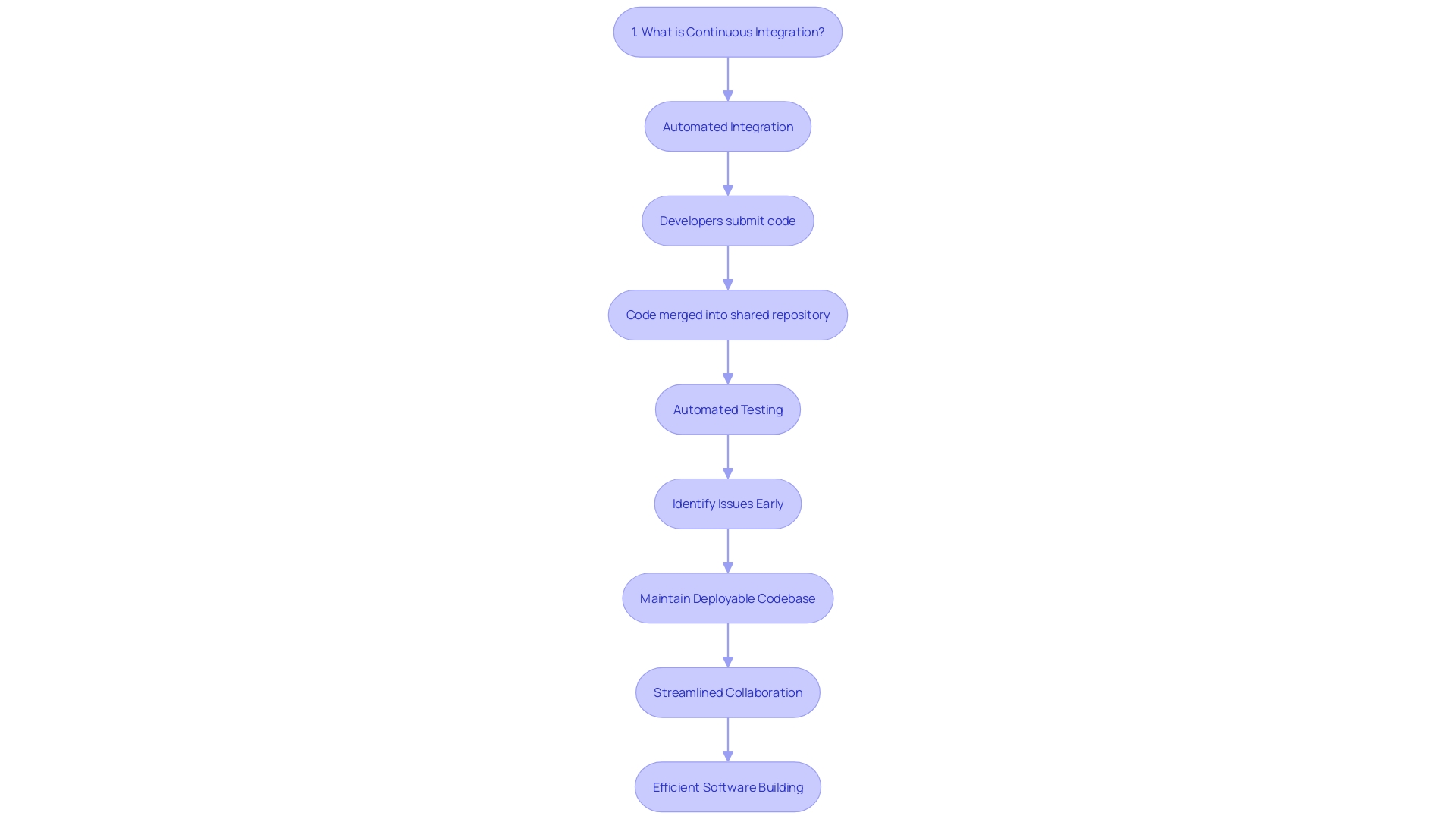
Version Control and Code Commit
Continuous Integration (CI) encapsulates a set of practices that drive modern software development, allowing teams to integrate their work frequently and detect integration errors as quickly as possible. It often involves a version control system, which is indispensable for managing changes to the source code. Developers leveraging version control systems can work collaboratively, safeguard their code's history, and swiftly revert to earlier versions if necessary.
The linchpin of CI is the code commit, where developers submit updates to a shared repository, thus initiating automated builds and tests. This not only facilitates a smoother workflow but also enhances productivity. A case in point is Workable's Applicant Tracking System (ATS), which has undergone numerous evolutions as the company's main software product.
Despite segmenting the repository into additional services, the ATS codebase and test suite continue to expand, underscoring the necessity for robust CI practices to manage growth effectively.
The rise in CI's adoption is evidenced by the surge in searches for 'CI/CD' according to Google Trends, reflecting its significance in the realm of software development. In this field, where coding, testing, and deployment are ongoing processes, the role of version control systems cannot be overstated. They are a subset of the overarching software development process, integral to maintaining the code's integrity over time.
Developers today have a wealth of tools at their disposal, including code editors like Visual Studio Code, which offers cross-platform support and an intuitive user interface to enhance efficiency. Open source projects are also a testament to the collaborative spirit inherent in the CI/CD philosophy, with 41% of developers contributing to such projects and an annual 38% growth in private projects, reflecting a strong community engagement and commitment to shared progress in software development.
Continuous Integration (CI) Stage
Continuous Integration (CI) is a pivotal practice in software development, ensuring that code changes by multiple developers are consistently merged into a shared repository. This process is crucial as it helps maintain the stability and functionality of the software while allowing teams to address integration issues promptly. The CI stage is more than just a simple merge of code; it's an orchestrated sequence of operations that includes compiling the source code into binary code, executing various automated tests, and generating reports to assess the health of the codebase.
The importance of CI is underscored by the evolution of software development practices, as evidenced by the experience of Workable's team with their Applicant Tracking System (ATS). By transitioning to a CI-friendly setup, they were able to overcome the challenges of their monolithic repository and enhance their development process. This transformation enabled them to carve out parts of the ATS into separate services, optimizing their integration and delivery pipeline.
Implementing CI effectively requires a comprehensive understanding of the tools and concepts involved. Real-world applications, particularly those written in languages such as Java or .NET, necessitate a build stage to create an executable file. This file encapsulates the necessary code and libraries required for the application to run.
By automating this build process and integrating frequent code contributions, teams can avoid the dreaded 'Integration Hell' and ensure that their products move smoothly from development to production.
Moreover, CI is not just about technical execution; it's a philosophy that enhances collaboration and quality in software projects. By committing code early and pushing often, developers can minimize conflicts and ensure that their contributions are in sync with the team's efforts. This approach is aptly described as 'Commit early, push often,' highlighting the proactive nature of CI in modern development workflows.
In essence, CI acts as the linchpin for successful software delivery, promising increased speed, improved quality, and reduced costs for businesses. It is an integral part of the CI/CD flywheel, a concept that encapsulates the full development and release lifecycle of a web application. From code writing to production deployment, every step benefits from the principles of CI, as they collectively contribute to a more agile, efficient, and quality-focused development process.

Automated Build and Testing
Continuous Integration (CI) is a pivotal practice in modern software development, streamlining the integration of code changes through automated builds and testing. By compiling source code, resolving dependencies, and creating executables or deployable artifacts, the build process ensures that software can be reliably constructed from its components. Automated testing, a crucial facet of CI, employs a suite of tests—ranging from unit tests that verify individual code units, to integration tests that ensure components work together, and regression tests that check for new errors in existing functionality.
The automated testing landscape is diverse, encompassing tests that assess various aspects such as functional correctness, security, and performance under load. Unit testing, specifically, zeroes in on the smallest functional segments of the code, and can be implemented before or after writing the actual code, embracing practices like Test Driven Development (TDD). Markos Fragkakis, a Staff Engineer at Workable, shares insights into the implementation of CI processes and the strategic decisions that bolster them.
He emphasizes the importance of clarity and preparation in defining the scope of test automation, selecting appropriate tools, and setting up a robust framework.
In the context of rapid technological evolution, the significance of automated quality control is escalating. By 2024, understanding the journey of code—its origins, the scans and tests it passes through, and its deployment environments—will be crucial. This chain of custody is not just about knowing what's in the software, but about being able to respond to issues with automated solutions.
As AI continues to transform the industry, platforms such as OutSystems are designed to mitigate Ai's pitfalls, such as generating incorrect or vulnerable code, while still benefiting from Ai's ability to enhance software development.
Adopting CI is a transformative decision that goes beyond technology; it's a commitment to a more agile, collaborative, and quality-focused development culture. This approach, supported by statistics, shows that continuous deployment (CD) as an extension of CI, allows for immediate user value delivery. CD's automated, no-human-intervention-required process demands a high level of confidence in the testing and deployment pipeline.
The evolution towards CD exemplifies the industry's movement towards more efficient, reliable, and user-centric software development.
Feedback Mechanism and Continuous Merging
Understanding the mechanics of Continuous Integration (CI) is foundational to its success, and one key aspect is the feedback loop it provides to developers. When code changes are submitted, they are immediately integrated and tested. If a failure occurs during this process, developers receive prompt notifications.
This rapid feedback allows for quick rectification of errors, which is essential in preventing the accumulation of issues and ensuring a smooth development flow.
The practice of continuous merging is integral to CI. It involves integrating code changes into the main branch after they have been verified through integration and testing. This constant flow of integration minimizes the dreaded 'Integration Hell,' a scenario where code changes from multiple developers lead to severe conflicts and integration challenges.
Frequent integration not only facilitates early detection of conflicts and bugs but also encourages a culture of collaboration. Developers work closely with shared code repositories, such as Git, ensuring that every code commit is a step towards a stable and functional software build. The objective is not just to integrate code but to do so in a manner that maintains the health of the software project, allowing teams to deliver high-quality software efficiently.
The importance of a build stage in the CI process cannot be overstated, especially for complex applications written in languages like Java or .NET. These applications require an executable file, containing all the necessary code and library dependencies, to be created through a build process. This ensures that the software runs as intended, without any missing components or library mismatches.
In summary, CI is a transformative practice that requires a firm grasp of its principles, from automated integration to continuous merging. By understanding and implementing these practices effectively, organizations can achieve a significant improvement in their software development processes, leading to faster delivery and more robust software.
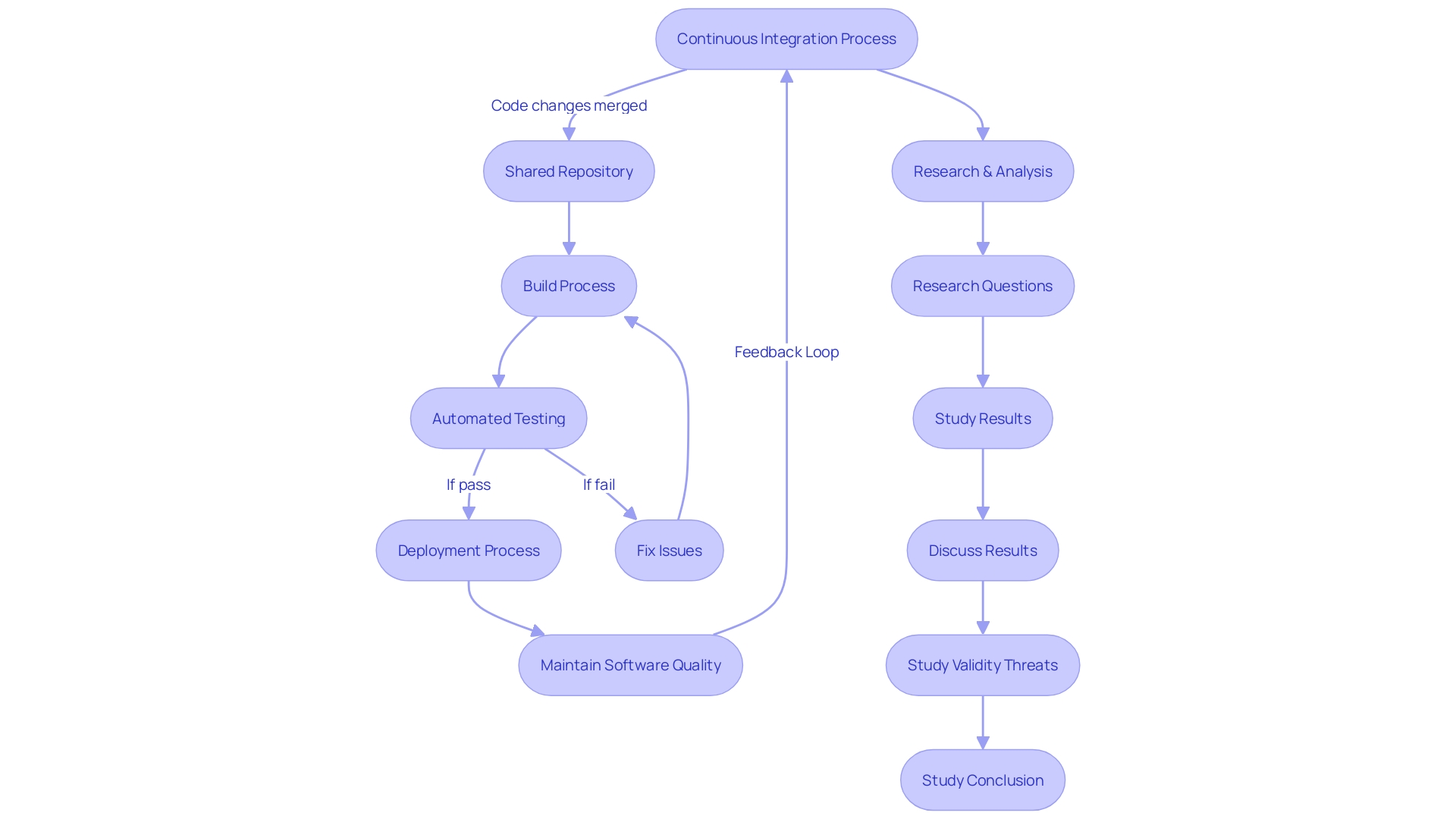
Benefits of Continuous Integration
Continuous Integration (CI) is more than just a development practice; it's a catalyst for team collaboration, code integration, and expedited software delivery. It's built on the regular and automated merging of code contributions from multiple developers into a central repository, aiming to pinpoint and remedy integration challenges swiftly. This practice is essential for maintaining the quality of code and ensuring compliance within industries where security and regulatory adherence are paramount.
Take M&T Bank, for example, a long-standing institution in the banking sector, which has embraced CI to uphold Clean Code standards across its development teams, thereby enhancing the maintainability and performance of its software amidst the industry's digital transformation.
The essence of CI lies in Automated Integration, where developers consistently integrate their code changes into a version control system. This system serves as the backbone of CI, allowing for efficient tracking of revisions, monitoring of modifications, and facilitation of seamless collaboration. As highlighted by Markos Fragkakis, Staff Engineer at Workable, the journey to implementing CI entails setting clear requirements, extensive research, and conducting proofs of concept before moving into the implementation phase.
Such strategic planning is crucial for organizations that wish to leverage CI for its full range of benefits, which include accelerated development cycles and enhanced software robustness.
Furthermore, the integration of automated testing into the CI process cannot be overstated. It embodies various testing methodologies, including unit testing and Test-Driven Development (TDD), ensuring that each code snippet meets the highest quality standards before integration. This commitment to quality is echoed in the words of software development experts who differentiate between continuous delivery and continuous deployment, emphasizing that CI is a discipline where software is not only built to be released at any time but also rigorously tested to ensure it's always ready for production.
Thus, embracing CI is not just a technological decision; it's a step towards a more agile, collaborative, and quality-driven software development environment. This transition is evident in the story of Workable's Applicant Tracking System, which has evolved from a single repository to an ecosystem of services, all benefiting from the rigor and efficiency that CI brings to the development process.

Early Detection of Issues
Continuous Integration (CI) is a software engineering practice that emphasizes frequent integration of code into a shared repository. By doing so, CI helps to surface integration issues and conflicts swiftly, enabling developers to address these problems early in the development process. This early detection is critical; it not only prevents the snowballing of unresolved issues but also significantly mitigates the time and resources expended on bug fixing at later stages.
In practice, CI is instrumental in improving the quality assurance process. According to a study, CI is linked with enhanced testing practices, improved quality assurance, and a reduction in reported issues. The methodology of this study aimed to establish potential causal relationships between CI and software quality, thereby underscoring the tangible benefits CI brings to software development.
A poignant example of CI's efficacy comes from Google's approach to managing software defects. By focusing on developer ecosystems, they've seen a marked decrease in common classes of defects across numerous applications and a large developer base. This reduction is attributed to a proactive stance on safe coding practices and avoiding vulnerable coding patterns, rather than relying solely on post-development defect identification techniques.
Moreover, the cost of addressing software bugs escalates as the product moves through the Software Development Life Cycle (SDLC). A bug that might cost $100 to fix during the planning stage can balloon to a $10,000 issue by the production stage. CI helps to identify such defects earlier in the SDLC, thereby averting the domino effect that results in amplified costs and project delays.
Furthermore, the distinction between continuous delivery and continuous deployment is worth noting. While both practices ensure that software changes are always in a releasable state, continuous deployment takes this a step further by automatically releasing every change to production, provided it passes all tests. This level of automation signifies that there is no human intervention, and the application is perpetually primed for use, which is a paradigm shift from traditional manual deployment processes.
In essence, CI is not just about merging code; it's about fostering a culture of shared responsibility, knowledge exchange, and risk reduction. It's a discipline that aligns closely with the objectives of delivering high-quality software efficiently and effectively, making it an essential practice for any forward-thinking software development team.
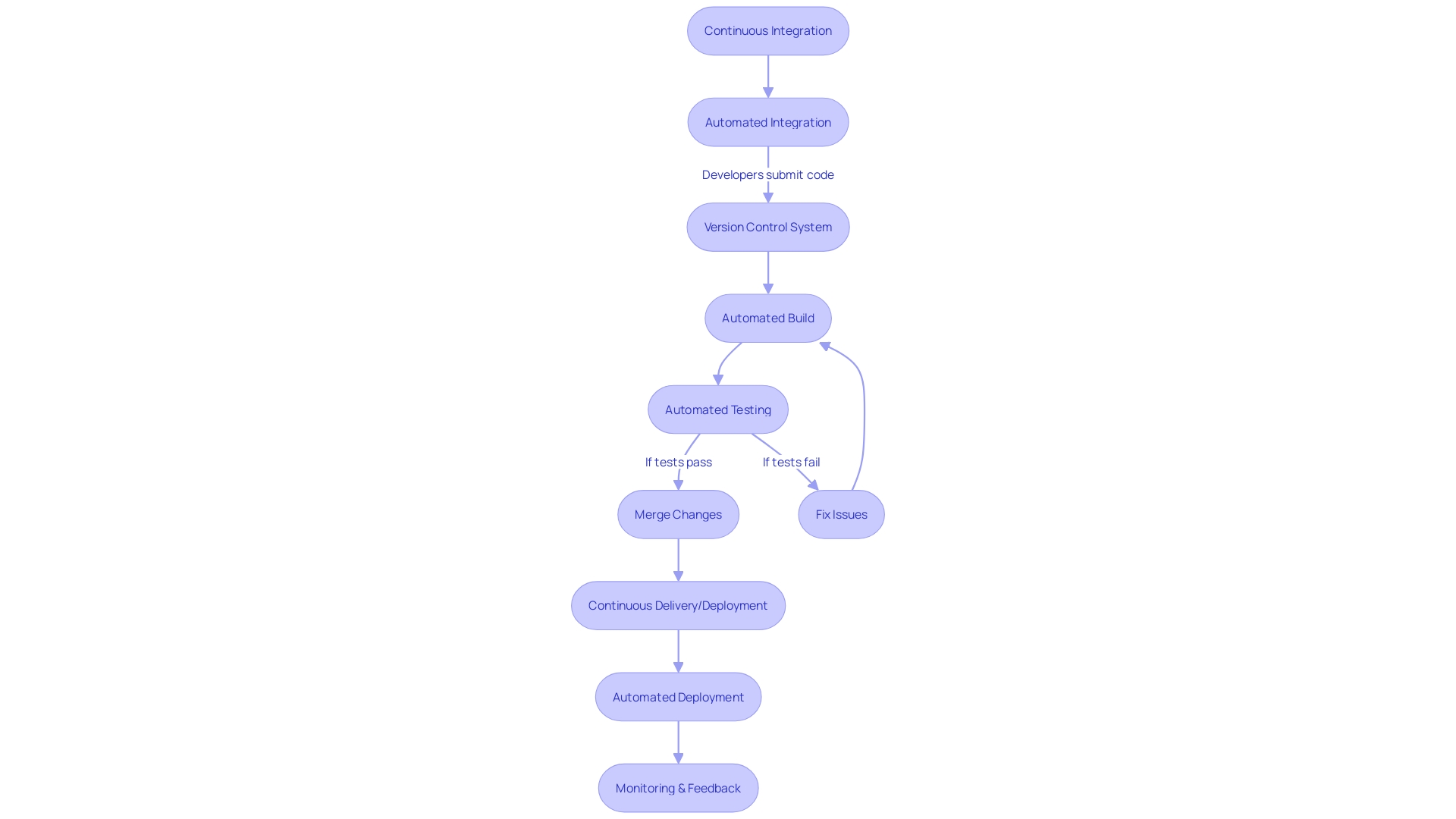
Faster Time to Market
Continuous Integration, or CI, is not just a technique for merging code changes; it's a keystone practice that reshapes the ethos of software development teams. By automating the integration and testing phases, CI facilitates a more cohesive and efficient workflow, allowing developers to assimilate their code changes into a central repository regularly. The immediate feedback on code quality that CI provides is invaluable, as it permits rapid adjustments, thereby reducing the integration issues that typically arise later in the development cycle.
M&T Bank, with its storied 165-year history, provides a compelling example of CI's transformative impact. In the face of the banking industry's digital upheaval, the institution has maintained high standards for the maintainability and performance of its software by adopting Clean Code practices across its development teams. This strategic move is critical for an industry where even minor software issues can lead to severe security breaches, financial losses, and tarnished reputations.
Moreover, the experiences shared by Markos Fragkakis, a Staff Engineer at Workable, underscore the significance of a well-orchestrated CI setup. Workable's Applicant Tracking System (ATS), which supports global hiring teams, has evolved over time. Despite its growth in code complexity and test suites, CI has been pivotal in facilitating Workable's expansion, ensuring software reliability even as parts of its business logic were spun off into separate services.
Statistics underscore the association of CI with enhanced testing practices, improved quality assurance, and fewer issue reports. This evidence lends weight to the assertion that CI is linked not only to faster development cycles but also to heightened software quality, as highlighted in a study investigating the causal relationships between CI and software quality.
In this dynamic landscape, open-source projects are gaining momentum, with an emphasis on securing dependencies and protecting branches. Tools like Docker have revolutionized the ease of creating and shipping software across platforms, reinforcing the need for robust CI processes to manage the complexities of modern software development.
As we delve deeper into the world of CI, it's clear that its benefits extend far beyond mere technical improvements. It's a strategic choice that fosters a more agile, quality-focused, and collaborative environment, vital for any organization striving to excel in today's fast-paced digital economy.
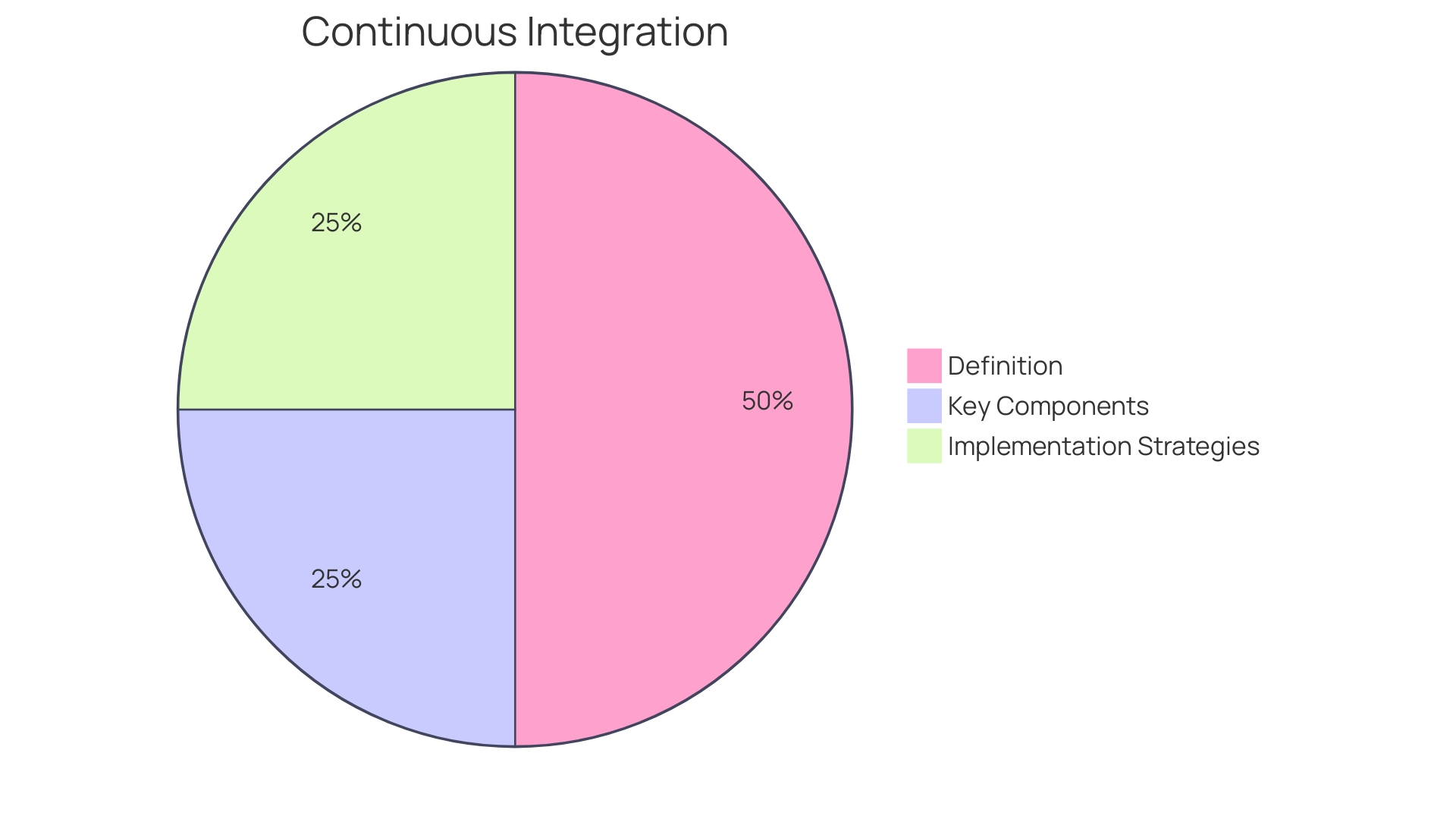
Improved Collaboration and Communication
Continuous Integration (CI) is a keystone in the arch of modern software development, pivotal in fostering a collaborative environment where developers synchronize their efforts to achieve superior code quality. In practice, CI facilitates a harmonious workflow by allowing developers to merge code changes into a shared repository with high frequency. This integration process is not only about blending new code with the old but also serves as a crucible to test the resilience and compatibility of the software under development.
CI's role in enhancing collaboration is exemplified by M&T Bank's initiative to establish organization-wide Clean Code standards. By adopting CI practices, the bank's developers were able to maintain code quality while adhering to stringent regulatory requirements—a testament to the practice's ability to unify team efforts towards a common goal of excellence in software development.
Moreover, Workable's journey with their Applicant Tracking System (ATS) demonstrates the tangible benefits of CI. Staff Engineer Markos Fragkakis shared insights on how CI enabled their team to efficiently carve out services from their monolithic codebase while keeping the growth and integrity of their software intact.
The need for such a collaborative approach is becoming increasingly clear as the nature of software development evolves. Research suggests that contrary to the traditional view of developers as solitary figures, many today are extroverted, thriving in team settings and seeking active engagement with colleagues and end-users. CI platforms have thus become vital forums for discussion and issue resolution, ensuring that everyone involved is aligned and informed.
By embracing CI, teams can capitalize on a culture of quality and collaboration, as highlighted by the Developer Experience Lab's findings. Such a culture not only enhances the quality and reliability of software products but also supports the health and productivity of the team, allowing them to focus on creating high-quality applications that closely align with user needs.
In a world where generative AI is poised to further transform software development, CI stands as a linchpin for developer teams, enabling them to keep pace with rapid technological advancements while maintaining the human touch that is critical to delivering exceptional software solutions.
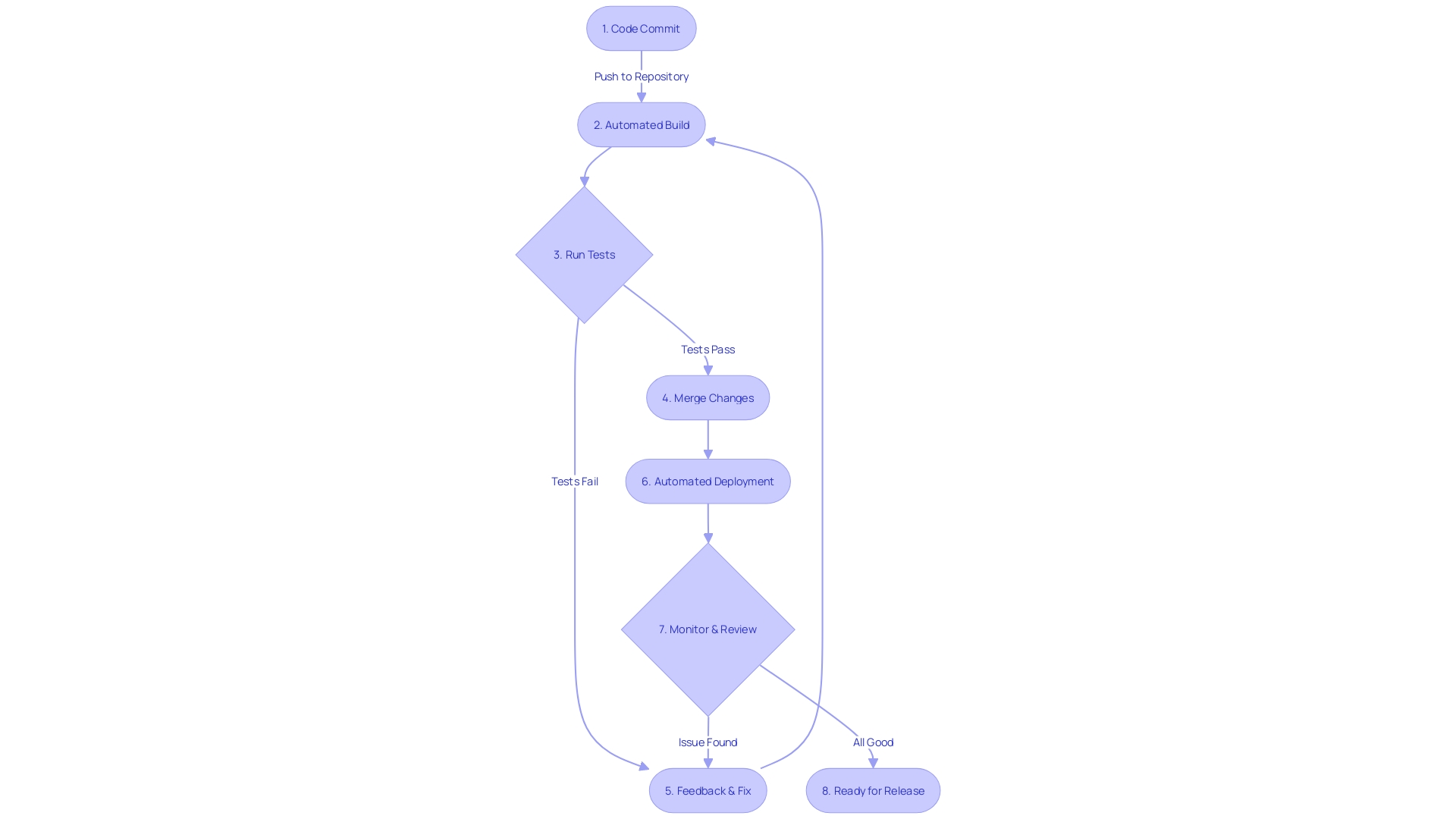
Enhanced Software Quality
Continuous Integration (CI) is a sophisticated software development practice where code changes from multiple contributors are regularly and automatically merged into a shared repository. This regimen is a cornerstone of modern software development, aiming to catch integration issues swiftly and foster a more efficient and collaborative coding environment. By employing CI, development teams can assure that every alteration to the codebase is tested through an automated suite, maintaining software quality and stability.
This practice is particularly pertinent in sectors like banking, where the digital landscape is rapidly evolving and the stakes surrounding software security and regulatory compliance are high.
For instance, M&T Bank, an institution with a history dating back to 1856, embraced the concept of CI to establish organization-wide Clean Code standards. This move was pivotal to ensuring the maintainability and performance of their software in an industry where introducing problematic software can result in significant financial losses and reputational damage.
Automated testing, an integral component of CI, ranges from unit tests that scrutinize the smallest units of code to more extensive integration and benchmarking tests. These tests can be implemented at any development stage, ensuring correctness and security before the code reaches production. Embracing automated testing and CI is not just a technological upgrade but a paradigm shift towards an agile, quality-focused, and collaborative approach to software development.
Such strategies for successful CI implementation, including tool selection and pipeline orchestration, are aligned with the insights shared by the 'Gang of Four' in the realm of software design patterns. They guide developers in structuring code to address specific problems efficiently, much like CI guides the integration process.
From the assembly lines of the automotive industry to software engineering, the principles of discovery, prototyping, and planning for reliable and consistent delivery are mirrored. As indicated in the World Quality Report, there has been a historical trend towards automation and shift-left methodologies in QA, reflecting a broader industry shift towards more strategic and efficient practices. CI is a testament to this evolution, contributing to reduced costs and enhanced software life cycles.

Best Practices for Implementing CI
Effective implementation of Continuous Integration (CI) hinges on adopting certain best practices that streamline the software development process and foster high-quality outputs. These practices include:
- Automated Testing: This is a critical component of CI, where specialized software performs tests without manual intervention, encompassing various types such as unit and integration testing, and evaluations like security and performance benchmarking.
- Unit Testing: Focusing on the smallest, independent units of code, unit tests can be created before or after the code is written, ensuring each function performs as expected.
- Test Driven Development (TDD): A proactive approach where tests are designed and implemented prior to the actual code, guiding development with predefined expectations of functionality.
Adhering to these practices can significantly mitigate risk, as evidenced by industry leaders like M&T Bank, who, driven by the rise of digital banking and regulatory demands, have set organization-wide Clean Code standards to maintain software quality.
The continuous quality evaluation of software attributes, such as performance and security, is also pivotal. The Linux Foundation, for instance, has become a nexus for best practice communities, offering resources to help organizations navigate open source management, which is becoming increasingly relevant as software systems evolve.
Furthermore, embracing CI/CD practices, as detailed by Markos Fragkakis of Workable, demonstrates the real-world application and benefits of a streamlined development lifecycle, from code conception to deployment.
In conclusion, the amalgamation of these practices and principles forms a robust framework for CI, leading to efficient, secure, and high-quality software developments that align with the dynamic needs of the industry and customer expectations.
Version Control and Branching Strategy
A well-architected Continuous Integration (CI) system is an essential component of modern software development. By enforcing a discipline where developers frequently merge their code changes into a common repository, CI helps mitigate the risk of 'integration hell'—a developer's bane where code conflicts proliferate. This practice, advocated by experts in the field such as Markos Fragkakis from Workable, is not just about avoiding merge conflicts.
It's about fostering an environment where code integration and testing are part of the daily workflow, enabling teams to detect issues swiftly and improve the quality of their software incrementally.
For instance, Workable's journey in carving out their Applicant Tracking System (ATS) into separate services demonstrates the significance of a robust version control system paired with a strategic branching approach. The result is a more refined integration process where developers can work on features or bug fixes in relative isolation, thereby enhancing overall productivity and software quality.
The effectiveness of CI is further validated by the 'Morning Brew,' a. NET software development blog, which highlights the importance of adopting practices like these for modern software initiatives. Additionally, the rise of AI pair-programming tools, as reported by GitHub Copilot studies, underscores the value of integrating sophisticated technologies into the development pipeline to boost developer productivity across all skill levels.
In essence, CI is not just about the technology but about the culture of collaboration it fosters. By committing early and pushing often, developers can ensure that their contributions are consistently aligned with the team's objectives, making the integration process a seamless aspect of the development cycle. This strategic integration of CI into the development process is crucial for any organization aiming to enhance its software delivery capabilities and maintain a competitive edge in the fast-paced world of technology.

Automated Testing and Test Coverage
Continuous Integration (CI) is a foundational practice in modern software development that necessitates the consistent amalgamation of code changes from multiple contributors into a single software project. This integration process is vital for early detection of conflicts and errors, ensuring that the software remains in a perpetually deployable state. Automated testing plays a crucial role in CI by validating code changes and guaranteeing that the integration does not disrupt the existing functionality.
M&T Bank, with its extensive history and forward-thinking approach, has embraced CI to maintain high-quality standards for its software. In recognition of the risks associated with deploying problematic software, particularly in the banking industry with its stringent security and regulatory demands, M& T Bank has established Clean Code practices. These standards help ensure maintainability and performance, illustrating the significance of automated testing in a sector where errors can lead to grave financial and reputational damages.
The rise of AI-driven testing marks a transformative moment in the field of software quality assurance. AI algorithms and machine learning significantly enhance testing efficiency and accuracy, enabling the detection of bugs and optimization of testing processes. This innovation has yielded substantial benefits, including up to a 60% reduction in testing time according to a Capgemini study, emphasizing the value of AI in achieving high test coverage and quality.
In the context of CI, achieving high test coverage is not simply a best practice but a strategic investment. High-quality test suites, strengthened by AI technology, allow organizations to adapt swiftly to market changes, meet customer expectations, and gain a competitive edge. They are a testament to the engineering principles that underpin software development, where the goal is to maximize value and minimize costs, whether in terms of time or financial resources.
Automated tests, especially when coupled with AI, reduce the manual burden on QA teams, allowing them to concentrate on critical software aspects. By integrating such advanced testing methodologies into CI workflows, companies are not only enhancing their development processes but are also setting a new standard in software reliability and performance.
Continuous Integration Server
Continuous Integration (CI) serves as a linchpin in modern software development, streamlining the way developers collaborate and integrate their code changes. The core of CI lies in its automated merging of contributions from various developers into a shared repository multiple times a day. This not only simplifies the process but also significantly reduces integration issues, allowing for more frequent and efficient testing.
Implementing a dedicated CI server is crucial as it centralizes the build, test, and deployment processes, turning code changes management and report generation into a seamless operation.
The practice of CI has been adopted globally, as evidenced by a case study from Workable, where the Applicant Tracking System (ATS) saw benefits from CI when transitioning from a single repository to multiple services. This transition exemplifies the necessity of CI in handling complex codebases and diverse development teams. Moreover, the 2024 Docker State of Application Development Report revealed that professionals across various company sizes are leveraging CI/CD technologies, emphasizing its ubiquity across the industry.
It is important to note that CI is not just about the automation of integration but also encompasses testing, which is crucial for maintaining software quality. Automated testing, as part of CI, is essential for achieving consistent and reliable results, and this can include a wide spectrum of tests, even at the system level.
The landscape of open-source development also reflects the importance of CI, as there's a growing trend towards securing dependencies and branches, with many developers turning to automation for this purpose. In such a rapidly evolving field, where technologies like Docker and Kubernetes are revolutionizing the way we develop and manage applications, CI stands out as a vital tool for maintaining efficiency and quality.
To truly appreciate the impact of CI, consider the perspective shared by Markos Fragkakis, Staff Engineer at Workable, who detailed the journey from setting requirements and conducting research to the implementation phase of the CI process. Such real-world experiences offer invaluable insights into the practical application of CI principles.
In summary, a dedicated CI server is more than a recommendation—it's a cornerstone for any development team aiming to enhance their workflow, improve code quality, and expedite feature delivery. By automating the integration, testing, and deployment workflows, teams can focus on what matters most: delivering robust, high-quality software that meets the ever-growing demands of users and businesses alike.

Creating a CI System: Steps and Principles
The process of establishing a Continuous Integration (CI) system is a multifaceted journey, encompassing a suite of steps and principles to ensure a smooth and efficient workflow. It begins with a reflective look at an existing setup, its limitations, and the specific challenges faced - a process well-documented by Markos Fragkakis, a Staff Engineer at Workable. In their case, the focus was on improving their Applicant Tracking System, a critical tool for global hiring teams.
The journey progresses through meticulous requirement setting, comprehensive research, and experimental proof of concepts. It's during these phases that automated testing becomes a cornerstone. Automated testing, in its essence, is the use of specialized software to conduct tests without manual intervention, spanning various types such as unit, integration, or based on metrics like correctness, security, and performance.
Unit testing, a crucial subset of automated testing, zeroes in on the smallest, independent units of code. These tests are pivotal and can be designed at any stage of development, aligning with the Test Driven Development (TDD) methodology where tests precede code creation.
The implementation phase is characterized by strategic decisions, as highlighted in the CI/CD flywheel concept. This metaphor encapsulates the complete development lifecycle, starting with customer needs analysis, progressing through code writing, testing, building, and culminating in deployment to production.
The insights gleaned from practical experiences, like those chronicled by Chris Alcock in 'The Morning Brew,' offer a daily digest of developments in the .NET software realm, reinforcing the significance of staying abreast with industry trends.
Moreover, statistical analysis, as detailed in a comprehensive study, underscores the correlation between CI practices and enhanced software quality. This research emphasizes the importance of understanding causal relationships to measure the tangible benefits of CI, which ultimately justifies the investment in this methodology.
In summary, the implementation of a CI system is a strategic endeavor that involves a series of well-planned steps, informed by industry research, case studies, and expert insights, all aimed at fostering software quality and streamlining the development process.
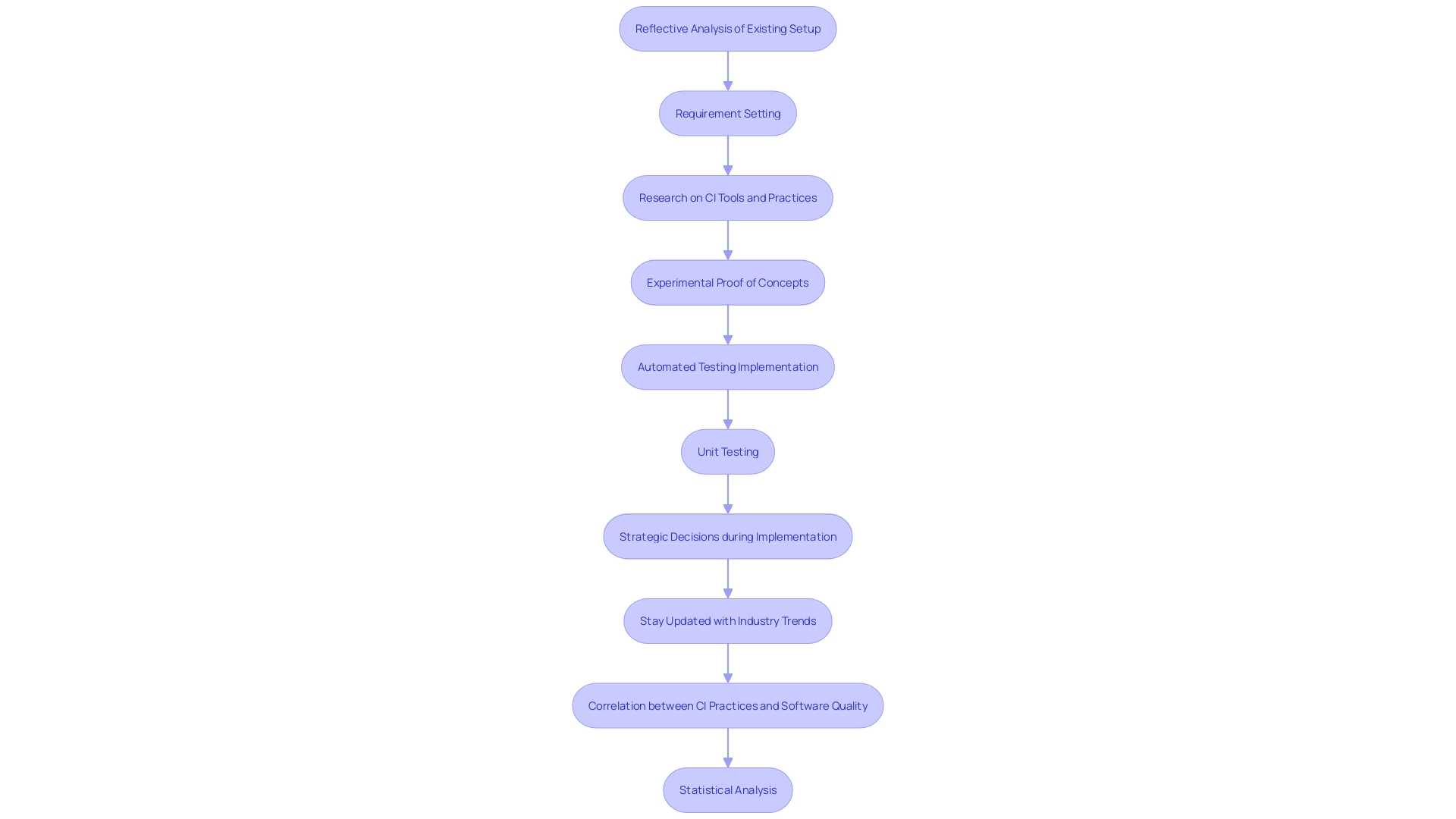
Define the CI Workflow
Defining the workflow for a Continuous Integration (CI) system is a foundational step in the journey towards streamlined software development. This process involves establishing patterns for integrating code changes, executing tests, and managing deployments, all crucial for maintaining high-quality software.
At the heart of CI is the frequent integration of work, ideally occurring multiple times a day. This practice ensures that the software remains in a working state and issues are caught early, thereby reducing risk and facilitating a smoother development cycle. The integration of code changes into a central repository is paramount.
Automated testing plays a vital role in this process, encompassing a broad spectrum of tests, from unit to integration, and assessing various quality metrics such as correctness, security, and performance. It's essential to distinguish between different testing methodologies. For instance, unit tests focus on the smallest units of code and can be implemented at any stage, while Test Driven Development (TDD) prescribes that tests are written before the code itself.
The experience shared by Markos Fragkakis, a Staff Engineer at Workable, sheds light on the practical aspects of implementing a CI system. The journey begins with understanding the limitations of the current setup, followed by defining requirements, researching potential solutions, and experimenting with proof of concepts. This approach culminates in an implementation phase that's informed by real-world experiences and strategic decisions.
As the velocity of software development accelerates, tools and practices such as CI and Continuous Delivery (CD) become indispensable. CD further expands on the principles of CI by automating the building, testing, and deployment phases, allowing for a consistent and repeatable process that can be more efficient than manual deployments.
By embracing these practices, organizations can release software with greater speed and frequency while reducing costs and minimizing delivery risks. This leads to an approach where updates are incremental and continuous, reflecting a dynamic and responsive development environment.
The CI/CD flywheel, a concept that represents the full development and release lifecycle, encapsulates the essence of CI and CD. This cycle begins with the identification of a customer need, progresses through coding, testing, building, and deployment, and ensures that the final product operates as intended. Such a comprehensive pipeline enforces the alignment between development activities and customer satisfaction, ultimately driving the success of software products.
In summary, the crux of establishing a CI system lies in a well-considered workflow that incorporates regular code integration, a robust automated testing strategy, and a clear pathway to deployment. This foundation not only enhances the quality and reliability of software but also aligns closely with the evolving practices that are shaping the future of software development.
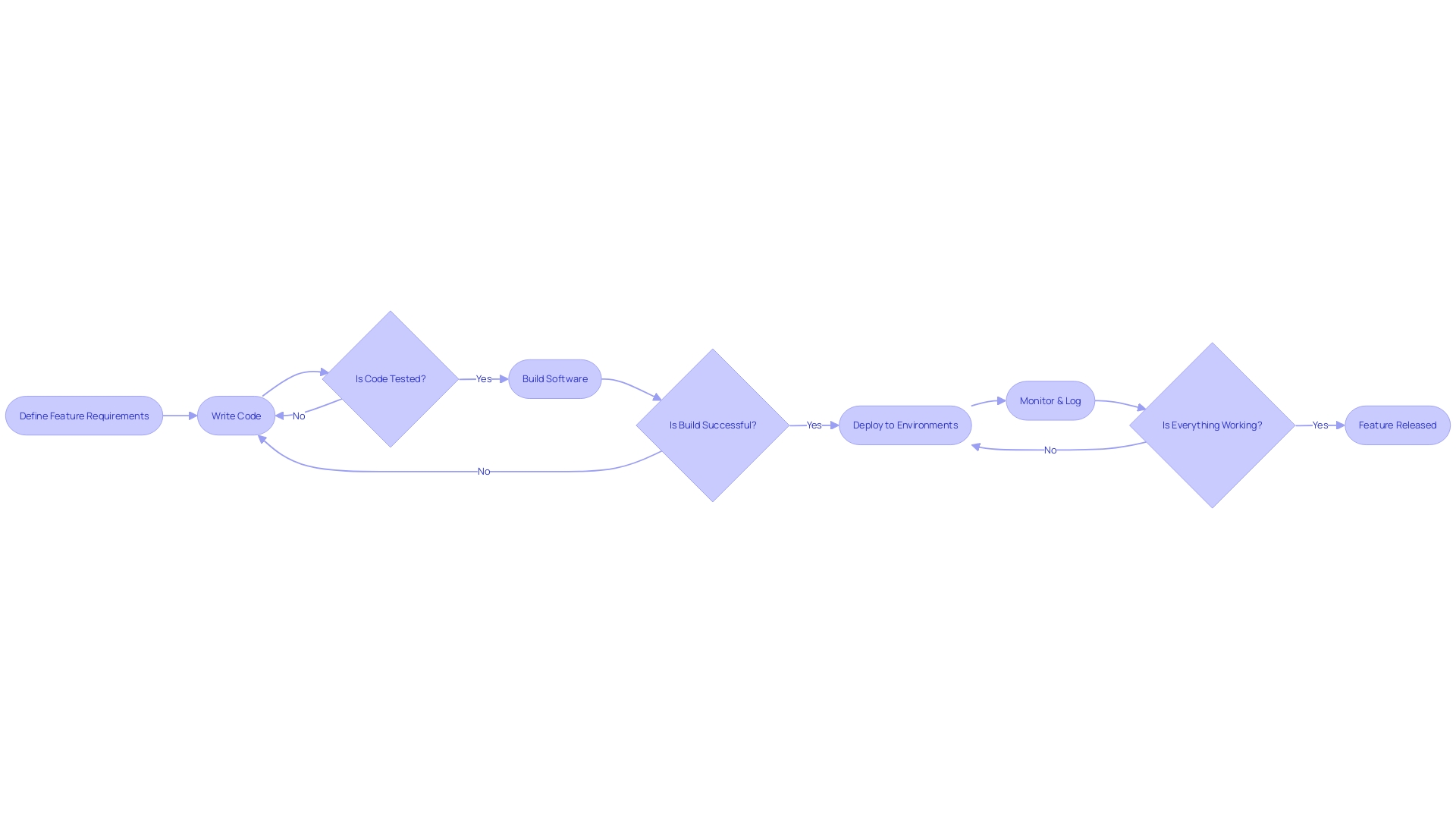
Set up a Version Control System
As the software development landscape evolves, the need for robust version control systems (VCS) has never been more pronounced. Git, in particular, has emerged as the de facto standard for tracking and managing changes across a diverse array of technologies—from low-level firmware to AI and cybersecurity. It's not just about keeping a record of changes; it's about enhancing the speed of development while maintaining the meticulous traceability required in fields like medical device software development.
Establishing a clear and efficient branch structure is critical. Consider incorporating two types of labels in your repositories: one to denote the component of the codebase affected, such as a tool or UX feature, and another to indicate the current status of the issue. This practice facilitates better organization and tracking of progress.
Recent reports underscore the growing reliance on VCS. According to the State of Developer Ecosystem 2023 report, which surveyed over 26,000 participants, there's a significant trend towards the integration of AI in development tools, with 77% of developers using ChatGPT and 46% utilizing GitHub Copilot. These statistics highlight the increasing complexity in software development and the critical role of VCS in managing it.
To adapt to market pressures that demand rapid product deployment, version control systems are not just a part of the software development process but a pivotal element that underpins the entire operation. They enable teams to manage code changes, collaborate efficiently, and ensure that software caters to a global, multilingual audience—demonstrating the importance of tools like Git in modern development workflows.
Configure the CI Server
In the realm of software development, the concepts of Continuous Integration (CI) and Continuous Delivery (CD) are not just methodologies, but they're pivotal to the successful and efficient delivery of software. The essence of CI lies in the integration of code changes into a shared repository by developers, which is a critical step in catching integration issues swiftly. This practice is complemented by CD, which aims to automate the release and deployment processes, ensuring that software can be production-ready at any time.
When configuring a CI server, it's essential to tailor it to the specific needs of your organization. A well-designed CI server should streamline the construction of build pipelines, automate testing frameworks, and seamlessly integrate with version control systems. These features are integral to fostering a Developer Experience (DevEx) that removes barriers and elevates the efficiency and satisfaction of software engineers in their craft.
The choice of tools and the setup of the CI environment directly influence how quickly and reliably developers can move from coding to deployment. For instance, automating various types of tests, including comprehensive system tests, is paramount to achieving consistent and reliable outcomes. Deployment procedures across different environments, such as development, staging, and production, must be consistent and repeatable to ensure the smooth transition of software releases.
Moreover, keeping a vigilant eye on the build and test results through notifications and reporting mechanisms is crucial. The ability to monitor and log activities in real-time or retrospectively helps in detecting and addressing potential issues promptly.
Recent advancements in CI technology, as evidenced by ongoing updates to platforms like TeamCity, highlight the industry's commitment to making CI/CD pipelines more efficient and cost-effective. These improvements are not just about speed but also security, as continuous integration is at the core of a development process that minimizes the risk of data exposure.
The widespread adoption of CI/CD practices and their integration into the DevOps culture reflects a transformative movement in software development, one that is gaining momentum with each passing year. The surge in the search term 'CI/CD' on Google trends underscores the growing importance and popularity of these practices among developers and organizations alike.
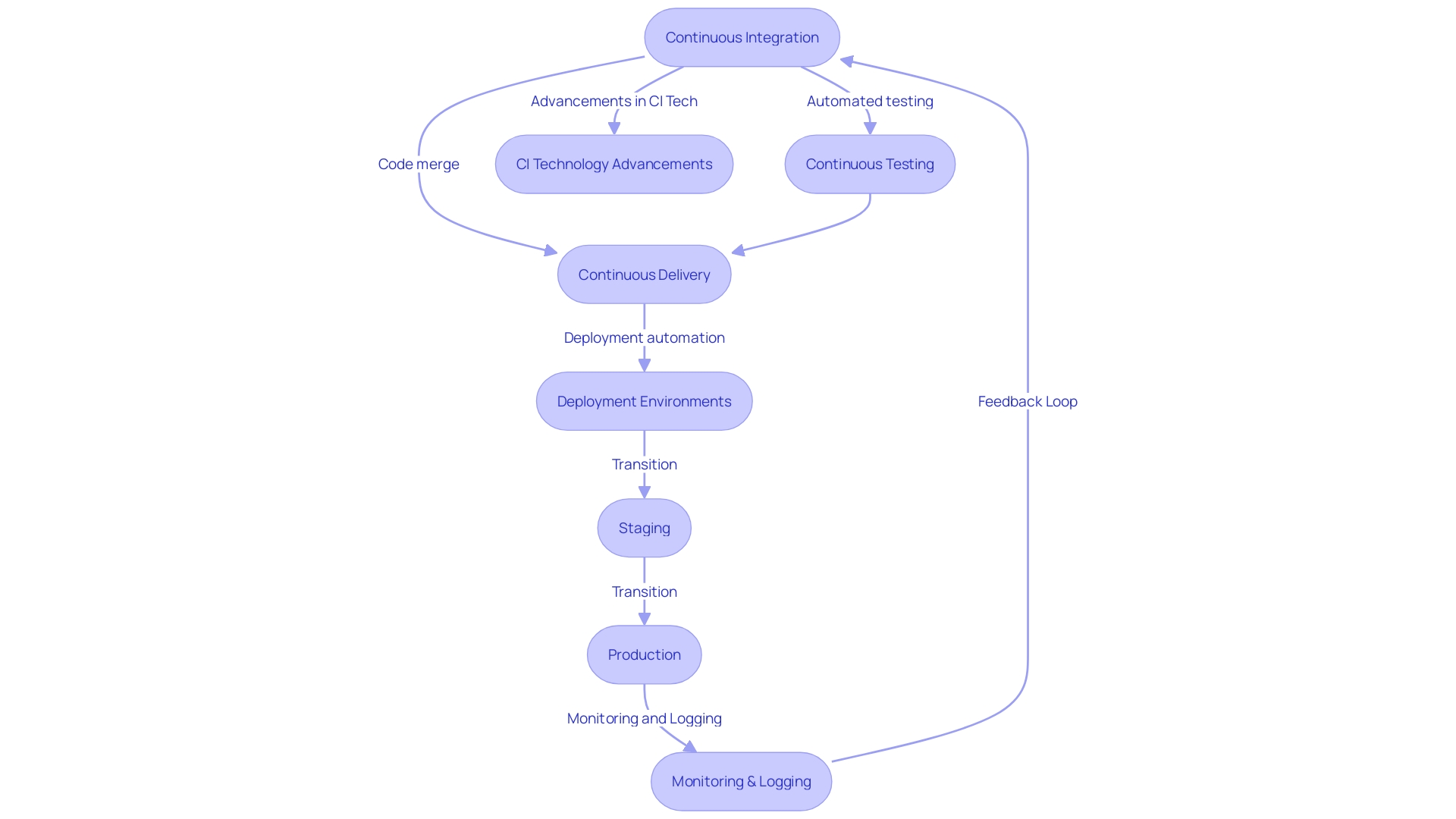
Automate the Build and Testing Process
Continuous Integration (CI) is a cornerstone of modern software engineering, enabling teams to tackle the challenges of innovation and rapid development cycles. By automating the build process, teams can compile and integrate code from multiple contributors seamlessly. CI tools serve to automatically compile and build the code upon each commit to the repository, ensuring that the codebase remains in a consistently deployable state.
Automation extends beyond the build process to encompass testing. Automated testing, a critical component of CI, includes a variety of tests—unit tests that validate individual code units, integration tests that ensure different modules work together, and other types such as load testing to assess performance under stress. These tests are crucial for identifying issues early in the development cycle, which in turn minimizes the cost and time needed for later fixes.
The implementation of a fully automated CI pipeline is exemplified by the case of Workable's Applicant Tracking System (ATS). As detailed by Staff Engineer Markos Fragkakis, the journey from a monolithic codebase to a service-oriented architecture necessitated a robust CI process. This process was meticulously planned and executed, paving the way for Workable to enhance its software delivery and maintain its competitive edge.
In addition, modern CI tools are equipped to perform visual comparisons and other sophisticated forms of testing, as highlighted by the capabilities of the Playwright framework. This enables developers to verify not only the functionality but also the user experience of applications across different scenarios.
Statistics underscore the transformative impact of CI. Quality assurance, once viewed as a liability, is now recognized for its ROI, with modern testing methods offering substantial cost savings. Moreover, Google's approach to development—saving snapshots of code and build logs—creates a rich dataset that informs and improves the CI process, exemplifying the cycle of design, build, test, deploy, and debug that is central to software development.
In conclusion, integrating CI practices into the development workflow is not just about automation; it's a strategic move that aligns with the rapid pace of innovation. It enables teams to deliver quality software rapidly and reliably, thereby maintaining relevance in a fast-evolving digital landscape.

Maintaining a Fast Build Process
Optimizing your Continuous Integration (CI) build process is more than a technical necessity; it's a strategic imperative that can significantly enhance the efficiency and effectiveness of your software development lifecycle. A prime example of this comes from Workable, where the engineering team, led by Staff Engineer Markos Fragkakis, faced challenges with their Applicant Tracking System (ATS). As the system grew in complexity, with an increasing number of tests and lines of code, ensuring a rapid build process became essential.
To maintain a brisk and effective CI environment, it's crucial to embrace practices such as incremental improvements and experimentation. This approach was evident in Workable's journey; they validated their understanding of the problems and explored various solutions without overcommitting resources. It's essential to recognize that CI is not just about the tools but also about the collective effort of the team.
The entire team must contribute and align towards common goals to achieve the desired CI efficiency.
Furthermore, practical steps can be taken to streamline the CI process. One such measure is the addition of a .dockerignore file to the repository. Similar to a. Gitignore file, the .dockerignore file informs Docker which files and directories to exclude during an image build, thus speeding up the process and saving valuable time.
The benefits of a well-maintained CI process are clear and supported by research, indicating that CI is linked to improved testing practices, higher quality assurance, and a reduction in issues reported. However, one must heed the wisdom that software should first 'make it work, make it right, then make it fast'. This aphorism underlines the importance of a progressive approach to optimization, ensuring that the CI build process remains robust and maintainable.
As the CI landscape continues to evolve, staying abreast of the latest developments is crucial. News from the industry, such as the upcoming beta release of TeamCity Cloud and the introduction of new plans tailored for smaller teams, reveals a trend towards more accessible and flexible CI solutions. With TeamCity Cloud soon available on AWS Marketplace, there is an evident shift towards accommodating the diverse needs of development teams, small and large.
In summary, a fast build process in CI is not just about speed; it's about smart, incremental improvements, collaboration, and staying informed on industry advancements. By embracing these principles, your CI process can transform into a strategic asset that supports your organization's goals for quality, efficiency, and innovation.
Minimize Dependencies
Efficient dependency management is a cornerstone of successful software development, particularly when it comes to Continuous Integration (CI) processes. Ci's automated verification, which includes building and testing code changes after each commit, demands a streamlined approach to managing external libraries and components that projects depend on—often referred to as dependencies.
The complexity of dependency management escalates as projects evolve in size and duration. Like relying on a precise recipe and the right ingredients to bake a cake, software development requires the correct libraries and frameworks to function as intended. Optimizing the number of dependencies is crucial; excess or mismanaged dependencies can introduce conflicts, slow down the build process, and even compromise the project's integrity.
To address these challenges, developers are turning to various tools and strategies. For instance, creating a .dockerignore file can prevent unnecessary files from slowing down Docker image builds, paralleling the practice of using. Gitignore files to exclude files from version control.
This technique not only accelerates CI processes but also enhances the maintainability of the codebase.
Reports like the 2024 Docker State of Application Development and insights into the Java ecosystem highlight the widespread recognition of these challenges within the developer community. The data-driven findings of such reports underscore the importance of efficient dependency management in today's rapidly evolving software development landscape.
By embracing dependency management tools and best practices, developers can ensure that their CI pipelines remain efficient, reliable, and capable of delivering high-quality software updates promptly.
Optimize Build Scripts
Continuous Integration (CI) is a cornerstone of modern software development, aiming to merge all developers' working copies to a shared mainline several times a day. The efficiency of the CI process can be significantly enhanced by refining build scripts, thereby reducing build times and accelerating the feedback loop for developers. To achieve this, unnecessary steps should be pruned, tasks should be executed in parallel where feasible, and caching mechanisms must be employed to bypass redundant operations.
Streamlining CI pipelines not only saves time but also reduces the risk of integration issues, ensuring a smoother and more reliable development cycle. This approach mirrors the ethos of Frederick P. Brooks Jr.'s 'The Mythical Man-Month', which emphasizes the importance of efficient project management. In practice, a focus on optimizing build scripts can transform a CI process from a bottleneck to a catalyst for rapid deployment and innovation.
The case of adopting monorepos illustrates this well, as it demonstrates how shared codebases can lead to increased build times if not carefully managed. By maintaining a vigilant approach to build optimization, as seen in the Beyond Boundaries hackathon case study, organizations can avoid the pitfalls that historically plagued large-scale projects like IBM's OS/360. The key is a collaborative effort across the team, underpinned by continuous experimentation and incremental delivery, to drive forward the technological vision of the organization.
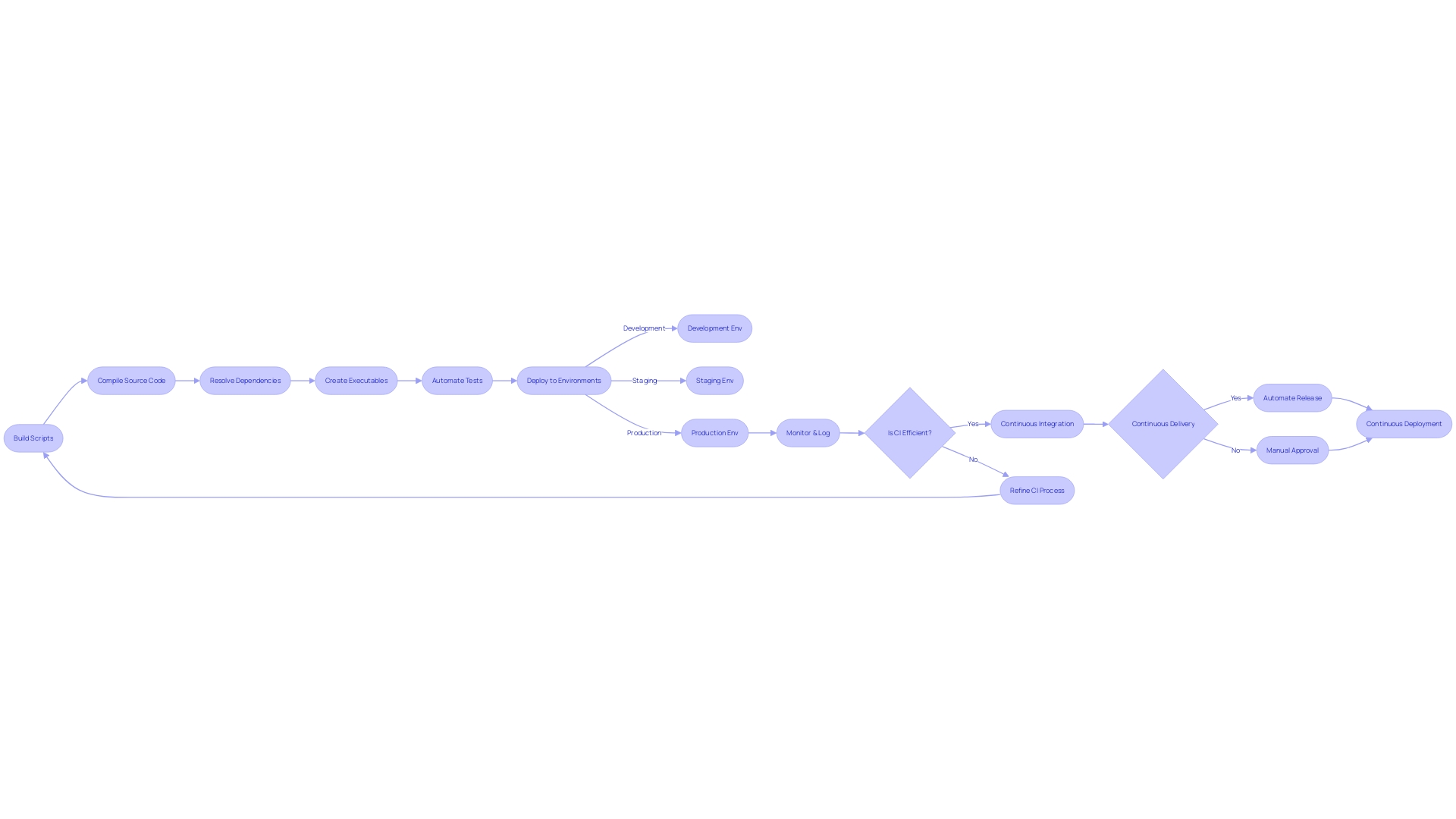
Utilize Build Agents
To optimize build performance in a Continuous Integration (CI) environment, it's crucial to distribute the build workload effectively. By leveraging multiple build agents, concurrent execution of build tasks is possible, which significantly trims down the total build duration. This approach not only accelerates the CI pipeline but also allows for more efficient utilization of resources, ensuring that no single agent becomes a bottleneck.
In practical terms, companies like Workable have faced the challenge of their Applicant Tracking System (ATS) monolith growing in complexity and size. As the ATS expanded with more lines of code and tests, it became apparent that a more scalable CI approach was needed. Distributing the build process allowed Workable to maintain its pace of development and deliver updates to thousands of teams globally without compromising on speed or reliability.
The improvement in CI processes can also be attributed to the internal development cycle, which includes coding, building, unit testing, and debugging. When these tasks are executed in parallel across different agents, developers can get faster feedback and iterate more rapidly on their code. This method aligns with the principles of delivering fast and incrementally, as well as the collective efforts of the entire engineering team.
Containerization plays a pivotal role in enhancing build performance by creating consistent environments for development, testing, and production. This eliminates the 'it works on my machine' problem by ensuring that the application runs the same way across all stages. With the use of containers, each build agent can operate in an isolated and controlled environment, further improving the reliability and consistency of the build process.
In summary, distributing the CI build workload across multiple agents and embracing containerization offers a robust solution for improving build performance, reducing build times, and maintaining a seamless development experience.
Tools and Frameworks for CI
Continuous Integration (CI) is a software development practice where developers frequently merge their code changes into a central repository, triggering automated builds and tests. The practice is essential for maintaining code quality and ensuring software is always in a releasable state. Key components of CI include a Version Control System (VCS) to track and manage code changes, and a repository where project files and historical versions are stored.
In the banking sector, CI is crucial due to the high-security demands and stringent regulatory requirements. For example, M&T Bank, with its long-standing history and focus on community-based banking, embraced Clean Code standards for its development team to ensure software maintainability and performance, which is vital in the digital transformation of the banking industry.
Automated testing plays a pivotal role in CI, encompassing various types such as unit testing and integration testing, often facilitated by Test Driven Development (TDD) where tests are created prior to the actual code. The goal is to detect issues early and maintain the consistency of the working state of the project.
The implementation of CI in organizations is not just a technological shift but a move towards a more agile, collaborative, and quality-centric approach to software development. The insights shared by Markos Fragkakis, Staff Engineer at Workable, demonstrate the practical application of CI in evolving their Applicant Tracking System, highlighting the importance of setting requirements, conducting research, and making strategic decisions during the implementation phase.
Several tools and frameworks facilitate the CI process, aiding in pipeline orchestration and the automation of testing. The benefits of adopting CI/CD practices include faster delivery of updates, enhanced quality and reliability of software, and the ability to respond swiftly to market demands and user feedback. This is supported by statistics showing that developers use multiple CI/CD technologies and frequently evolve their pipelines to meet the changing needs of software development.
Jenkins
Jenkins, an open-source continuous integration (CI) server, is renowned for its robust plugin ecosystem and adaptability. It is designed to streamline the process of integrating code changes from multiple developers into a single software project. By enabling automation in building, testing, and deploying applications, Jenkins serves as a crucial tool in the CI pipeline, facilitating a more collaborative and efficient development environment.
The commitment to continuous improvement is evident in the Jenkins community, where contributors play a significant role in enhancing the platform's capabilities. Recent initiatives have highlighted the contributions of key individuals who have shaped Jenkins into the tool it is today. These contributors, from diverse backgrounds, bring a wealth of experience and personal insights that underscore the global impact of Jenkins.
Bi-weekly contributor spotlights aim to celebrate these individuals and provide insights into their experiences with Jenkins, fostering a sense of community and human connection.
Continuous Integration is a transformative practice in software development, characterized by the regular and automated merging of code changes. This approach mitigates integration issues early on and promotes a streamlined development process. The integration of Jenkins into a development workflow enables teams to commit code frequently, thus reducing the likelihood of merge conflicts and allowing for more frequent testing.
This practice, encapsulated by the mantra 'Commit early, push often,' is fundamental to avoiding the pitfalls of 'Merge Hell,' a situation where code integration becomes excessively complex due to infrequent commits.
As organizations adopt Continuous Integration with tools like Jenkins, they unlock numerous benefits. The automated nature of Jenkins allows for the creation of executable files from code written in languages like Java and .NET, which incorporate all necessary codes and library dependencies. This automation ensures that software runs successfully and is a testament to the importance of understanding the CI/CD process, the roles of each tool, and the metrics that define success.
Such knowledge is essential, whether it's for onboarding new team members or discussing project strategies.
In conclusion, Jenkins stands as a testament to the collaborative efforts of the software development community. Its extensive plugin support and flexibility, combined with the dedication of its contributors, make it a cornerstone in the realm of Continuous Integration, driving the evolution of software development practices towards greater agility and quality.
Travis CI
Continuous Integration (CI) is an indispensable practice in modern software development that involves the frequent and automated merging of code changes into a shared repository. This method is central to a collaborative and efficient approach to software building, aiming to pinpoint and resolve integration problems swiftly, as soon as they arise.
Travis CI, a cloud-based CI service, is engineered to integrate seamlessly with GitHub projects. It simplifies the setup process, allowing developers to synchronize their code with GitHub repositories effortlessly. The automated testing feature of Travis CI runs a designated script, such as 'gradlew alltests', to validate all code changes, including user interface and performance tests.
In the context of rapid technological evolution, it's essential to consider the impact of new software versions, such as Python 3.12, on CI environments. The update process may present challenges, particularly if dependencies are not yet compatible with the latest iteration. Nevertheless, CI tools like Travis CI enable developers to test their applications against multiple Python versions simultaneously, ensuring compatibility and continuous integration despite the evolving landscape.
The Docker State of Application Development Report 2024, sourced from over 1,300 respondents, underscores the significance of CI tools in today's development ecosystem. The report reveals a diverse usage of tools and highlights the industry's gravitation towards cloud services and microservices architectures. It is evident that developers are leveraging CI to not only accelerate development cycles but also to enhance the quality and security of their software, embodying a shift-left approach.
Incorporating CI into the development process is not just a technical adjustment but a cultural transformation reflective of the organization's values. By focusing on the automation and efficiency that CI platforms like Travis CI provide, development teams can build software in the simplest and most effective way possible, resonating with the agile philosophy of continuous improvement.
CircleCI
CircleCI, a cloud-based CI/CD platform, is acknowledged for its comprehensive support of various programming languages and frameworks. Its intuitive interface facilitates efficient build processes, including parallelism, which can significantly expedite build times and enhance productivity. By integrating CircleCI into their workflow, organizations such as Workable have experienced tangible benefits.
Workable's Applicant Tracking System (ATS) underwent a transformation, evolving from a monolithic architecture to a more modular approach. Despite this shift, the ATS's codebase and test suites expanded, highlighting the need for robust CI/CD solutions to manage increasingly complex software development cycles.
The significance of CI/CD tools extends beyond just simplifying the process; they foster increased velocity and agility, enabling businesses to swiftly adapt to market shifts. Automated testing and deployment streamline the delivery pipeline, which in turn augments software quality and customer satisfaction. Moreover, the cost efficiencies realized by automating manual tasks and honing the software development lifecycle are undeniable.
In the broader industry context, projects like Radius, which seek Cloud Native Computing Foundation (CNCF) inclusion, address the complexity of cloud applications by offering infrastructure automation and promoting a multi-cloud strategy. This aligns with the overarching trend of simplifying and refining the software development process through innovative tools.
Statistics from the 2024 Docker State of Application Development Report underscore the dynamic nature of the development landscape, with developers often employing multiple technologies within a single project. This adaptability is critical, as is the ability to evolve CI/CD pipelines to meet the changing demands of software development.
The journey of CI/CD evolution is continuous, as noted by thought leaders who emphasize the importance of feedback from open-source communities and the impact of early adopters. The role of CI/CD in mitigating security risks has also been spotlighted in the wake of high-profile breaches, underscoring the necessity for secure CI/CD practices.
In summary, CircleCI exemplifies the ongoing innovation within the CI/CD arena, providing tools that align with the current and future demands of software development for businesses seeking to remain competitive and secure in an ever-changing technological landscape.
Ensuring Rapid Feedback and Collaboration
Continuous Integration (CI) stands as a cornerstone in modern software development, emphasizing the importance of rapid feedback and collaborative work. Ci's effectiveness is exemplified by Bosch's implementation of a digital twin to accompany their solid oxide fuel cell (SOFC) system. This digital counterpart allows for real-time visualization and monitoring of the SOFC, facilitating immediate feedback and adjustments to optimize performance throughout the system's lifecycle.
Similarly, TBC Bank's agile transformation underscores the role of CI in reducing complexity and expediting digital product delivery, thereby enhancing customer and employee experiences. This transformation is vital for TBC Bank's international expansion and digital business growth, showing how CI can streamline operations across a growing enterprise.
Moreover, the 'Fail-Fast Strategy' further underlines the necessity of early detection and resolution of potential issues within the development cycle. By integrating this strategy, software development teams can swiftly identify and address failures, fostering a culture of continuous improvement and risk mitigation.
These case studies demonstrate CI's pivotal role in enabling organizations to adapt swiftly to changing demands and maintain a competitive edge in their respective fields. The consistent theme across these examples is the strategic use of CI to drive efficiency, quality, and innovation in the ever-evolving landscape of technology and business.
Automated Notifications
Implementing a robust Continuous Integration (CI) system is pivotal for modern software development. One of the crucial components of this system is establishing automated notifications. These notifications serve as an immediate feedback mechanism for developers, alerting them when build and test processes yield results.
This immediate feedback is vital for fostering a culture of continuous improvement and rapid response to potential issues. At Workable, for instance, the evolution of the Applicant Tracking System (ATS) necessitated a CI system that could handle a growing codebase and an increasing number of tests.
Automated notifications are not just about informing developers of a successful build or a failed test; they represent a shift towards proactive issue resolution and enhanced collaboration. As noted by Markos Fragkakis of Workable, implementing such systems requires careful consideration of the company's specific requirements and thoughtful integration into existing workflows. It's about creating a CI process that developers can depend on to maintain high-quality standards in a fast-paced development environment.
The benefits of this approach are evident in the broader industry as well. With the rise of AI in software development, platforms like OutSystems are mitigating the risks associated with AI-generated code by ensuring developers remain in control. This parallels the concept of automated notifications in CI, wherein the system aids the developer without supplanting their expertise.
The AI Mentor System by OutSystems exemplifies this by offering AI-based suggestions while leaving the final decisions to human developers.
In the context of CI, the importance of automated notifications cannot be overstated. They are an integral part of a system that values early detection of issues, seamless integration of changes, and maintaining a high level of code quality. As CI tools and practices continue to evolve, embracing automated notifications will undoubtedly play a significant role in shaping more efficient and reliable software development processes.
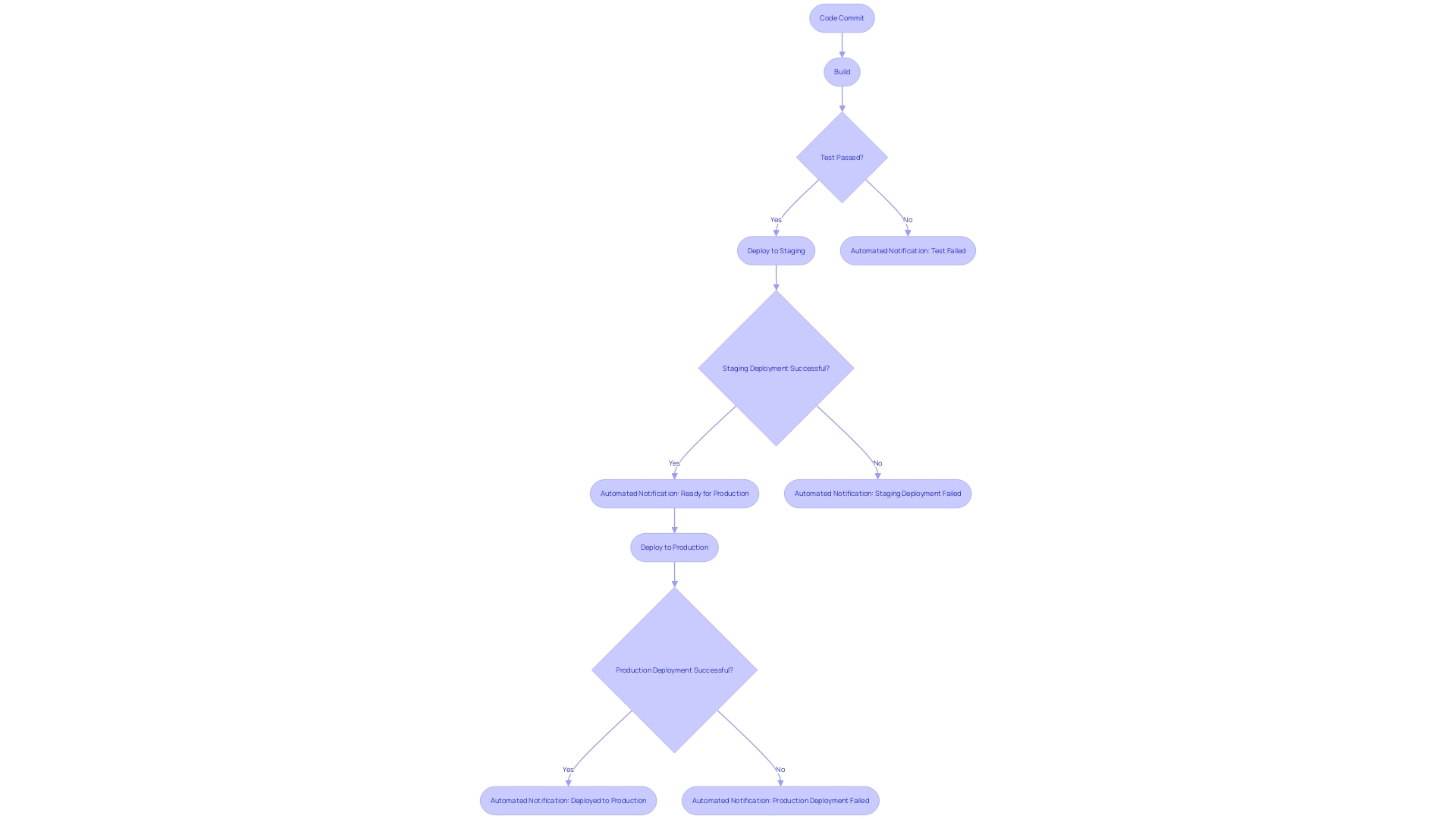
Centralized Issue Tracking
Implementing a centralized issue tracking system is crucial in managing and addressing integration issues that arise during the Continuous Integration (CI) process. A well-organized issue tracker categorizes issues with labels, such as 'Component,' pinpointing areas of the codebase affected, and 'Status,' indicating the progress of resolution. It's essential for issues to be actionable, allowing team members to tackle them promptly.
To maintain a clear overview and manage complexity as projects grow, automated techniques using natural language processing are employed to mine issue tracking data. This approach aids in navigating the vast textual data within issue trackers, which can encompass dozens of projects and thousands of issues, ensuring that relevant issues are easily identified and understood.
Furthermore, a contextualized linking of issues to related pull requests and existing issues is beneficial. It fosters institutional knowledge, aiding in understanding the rationale behind code and feature decisions—a critical aspect for large-scale projects where reproducibility alone is insufficient.
According to recent studies, 18.6% of Java and JavaScript projects from 2022 are no longer maintained, and nearly 10% have reported security breaches due to vulnerabilities in open-source components. With a surge in the use of AI and machine learning components by 135% over the past year, it is evident that the complexity and maintenance challenges of software projects are escalating.
By employing a centralized issue tracking system, organizations can enhance collaboration, expedite issue resolution, and maintain a high level of software quality and security. This is particularly relevant in environments where a monorepo strategy is used, which, despite its scale, allows for a unified approach to software development and maintenance, as indicated by the experiences of developers at global tech companies.
In conclusion, strategic use of issue tracking systems supports the agile, collaborative, and quality-centric ethos of Continuous Integration, aligning with the goal of implementing CI to facilitate swift feature delivery and ensure software robustness. Statistics show that 80% of developers consider testing integral, with 58% developing automated tests, highlighting the importance of integrating testing within the CI pipeline for effective software development.
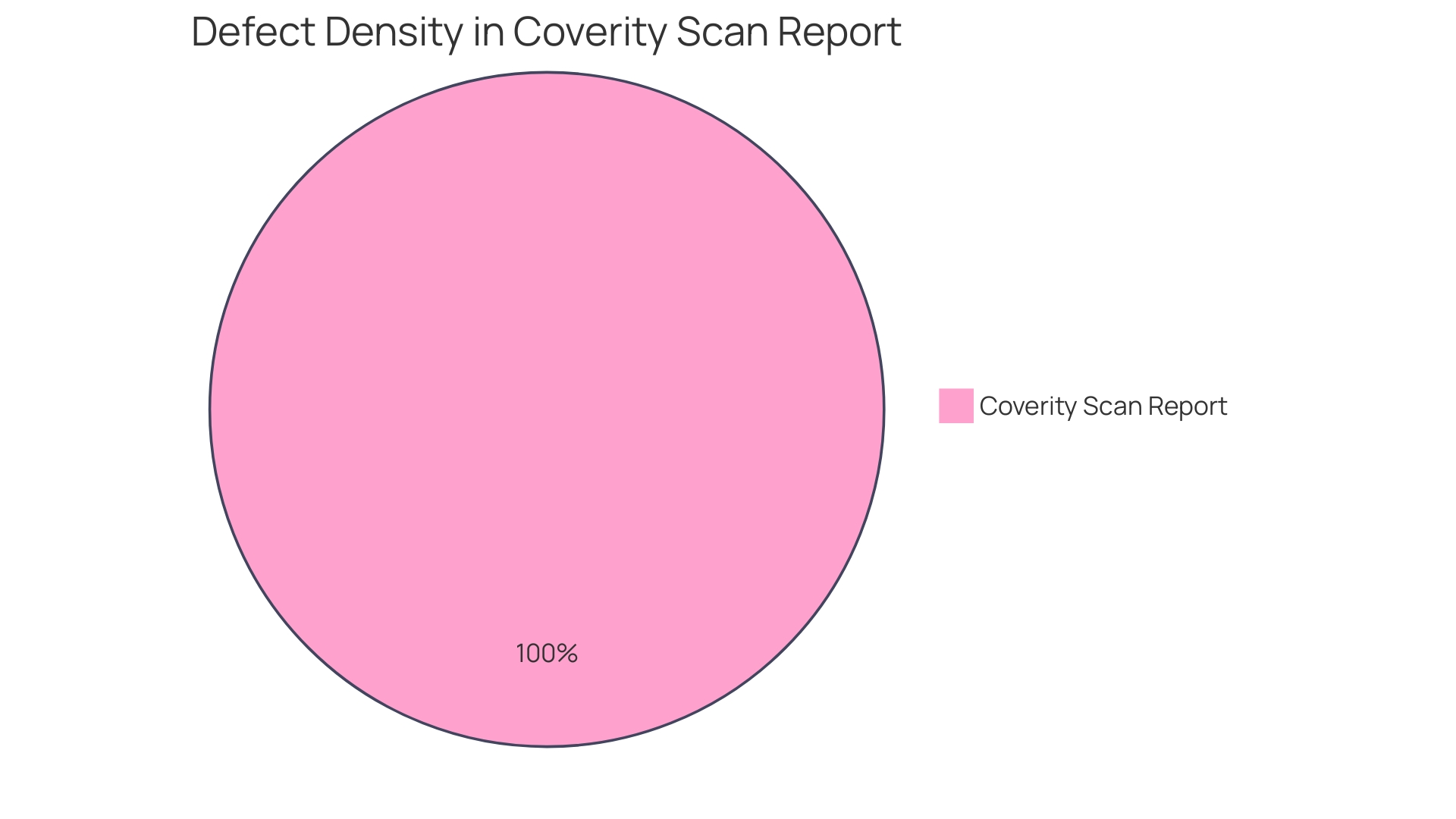
Streamlining Testing and Deployment
Continuous Integration (CI) is more than a set of processes; it's a linchpin of modern software development. Effective CI practices can see teams delivering software at an unprecedented pace, ensuring that their products remain competitive in today's fast-moving digital landscape. A case in point is Workable's Applicant Tracking System (ATS), which evolved from a single repository to a complex system with multiple services.
Despite shedding some business logic components, ATS saw a steady growth in lines of code and the number of tests over the years—demonstrating the scalability challenges CI must accommodate.
The implementation of CI does not end with the integration of code; it extends to strategic testing and deployment, which are vital for a seamless workflow. The ATS experience, shared by Staff Engineer Markos Fragkakis at Workable, underscores the importance of tactical decisions during CI implementation. These insights are invaluable for any organization looking to refine its CI processes.
In the evolving field of software development, the adoption of tools like Docker has revolutionized container utilization and has made the development, packaging, and distribution of applications across various platforms more manageable. Similarly, the enhanced control plane management introduced by Upbound's Spaces showcases the continuous innovation in CI tooling.
However, with innovation comes the challenge of security. The Open Source Consumption Manifesto calls attention to the serious consideration needed for the security of open-source software, a cornerstone for many CI pipelines. The prevalence of security risks, such as the fake alerts in open-source projects and crypto mining threats to cloud resources, underscores the need for vigilant and robust testing practices within CI frameworks.
The philosophy of 'make it work, make it right, then make it fast' encapsulates the iterative nature of CI, where each code integration is a step towards a more refined and efficient product. The four quadrants of testing provide a structured approach to determining the best testing practices for a given business scenario, balancing automated and manual testing to meet specific project needs.
The statistics speak for themselves: software testing, once seen as a costly necessity, is now recognized for offering significant ROI when modern methodologies are employed. As developers navigate the complexities of creating simple yet effective solutions, CI stands as the methodology that not only facilitates this creative problem-solving but also ensures the quality and reliability of the software produced.
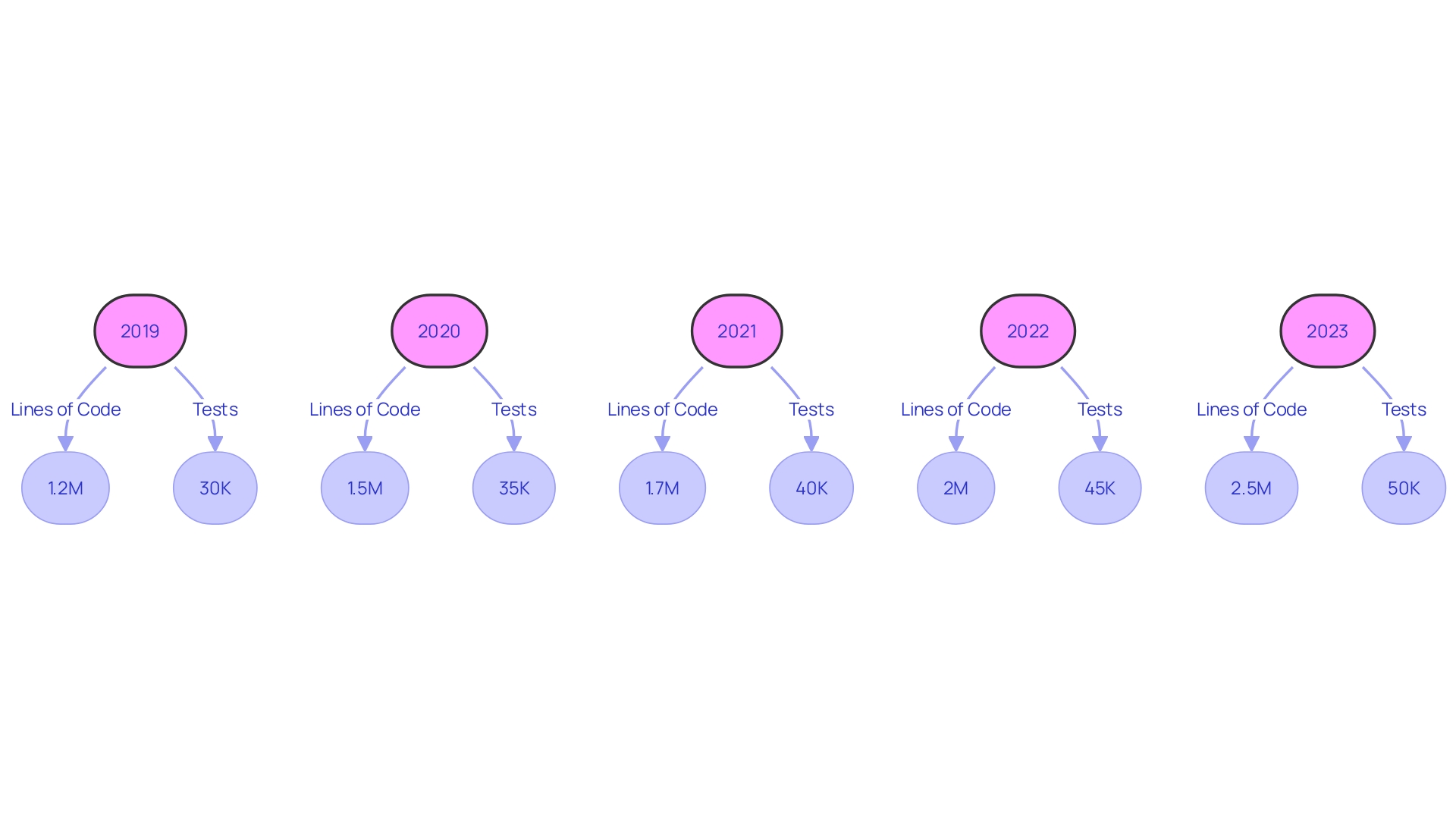
Test Parallelization
To optimize the efficiency of testing in software development, particularly in Continuous Integration (CI) environments, it is essential to reduce the total time required for testing. One practical approach is to parallelize test execution. This method involves running multiple test cases simultaneously, either by utilizing testing frameworks designed to support concurrent execution or by distributing tests across several machines.
This strategy not only accelerates the testing process but also enables a more effective utilization of resources.
The concept of parallel testing, or Shadow Testing as it's known, has been implemented in various organizations to great effect. For instance, at Workable, the development team managed the Applicant Tracking System (ATS) by breaking down the monolithic repository into smaller services to improve testing and deployment processes. By employing parallel testing, they could observe and analyze the behavior of the new system in a live environment, alongside the existing production system, without impacting end-users.
Despite the potential advantages, caution must be exercised to prevent introducing flakiness into tests due to concurrency issues, which can lead to nondeterministic results. An instance of this was noted when a concurrency strategy meant to expedite a test inadvertently led to erratic outcomes because the Bank Account implementation lacked thread safety.
Amdahl's Law also plays a crucial role in understanding the limitations of parallel testing. It states that the overall speedup of a program's execution is restricted by the portion that cannot be parallelized. This implies that while parallelization can significantly reduce execution time, it is bound by the sequential elements of the program which cannot be optimized in the same manner.
When planning to automate and parallelize testing, several key steps must be taken, including defining the scope of test cases, selecting appropriate tools that align with budget and compatibility requirements, and configuring the testing environment to mirror production conditions as closely as possible.
In conclusion, the deployment of parallel testing in CI can bring about substantial benefits in terms of risk mitigation and efficiency, provided it is implemented with careful consideration of the inherent limitations and potential pitfalls of the testing methods employed.
Automated Deployment
The implementation of automated deployment mechanisms serves as a critical component in the modern software release process. It is not only about delivering new features, bug fixes, and improved documentation but also about ensuring that these changes reach users in a consistent and reliable manner. Consider the experience of maintaining the Diffusers library, where each release culminates in distribution via platforms like PyPI for Python libraries.
Streamlining the release process is an ongoing learning curve, valuable for both personal projects and larger organizational responsibilities.
In the context of Continuous Integration (CI), automated deployment is a key ingredient that enables the philosophy of continuous delivery and deployment. CI facilitates a collaborative environment where code changes are integrated and tested regularly, thereby setting the stage for automated deployment. The distinction between continuous delivery and deployment lies in the actual production usage of the software changes; with continuous deployment, every change that clears the pipeline is immediately released to customers.
Automated deployment aligns with the larger trend in the software development community, as evidenced by the latest Docker State of Application Development survey, which highlights the tools and processes developers prioritize. With over 1,300 developers participating, the survey underscores the industry's movement towards automation and efficiency.
Reflecting on the evolution of software engineering, we draw parallels to the annual shutdowns in manufacturing plants for line maintenance and updates. The lessons from these shutdowns—discovery, prototyping, and planning—translate seamlessly into the software realm where deployment must deliver the end products reliably and repeatedly.
As we embrace continuous deployment, we harness the advantages of automated testing and pipeline orchestration. The largest survey of data science and analytics professionals reveals the multifaceted nature of deployment success, spanning tools, technology, and challenges. Continuous deployment, automated by design, eliminates manual intervention, ensuring that applications remain in a state of readiness for production.
Adopting an automated deployment strategy is not just a technological choice. It is a commitment to a more agile, collaborative, and quality-centric approach to software development that resonates with the strategic direction of modern technology initiatives.
Monitoring and Measuring CI Performance
To truly enhance the efficacy of a Continuous Integration (CI) system, it's imperative to not only implement but also meticulously monitor and measure its performance. In this pursuit, qualitative metrics stand as a beacon of insight. These metrics go beyond the quantitative data, tapping into the quality of the software and the developer experience.
For instance, AI pair-programming tools like GitHub Copilot have revolutionized productivity across the board—especially for junior developers—by predicting and completing snippets of code. The benefits are multifold, encompassing improved task times, heightened product quality, and reduced cognitive load, all of which contribute to a more enjoyable and educational coding environment.
The significance of CI/CD observability cannot be overstated. It's the linchpin that ensures reliability and comprehensibility throughout the development lifecycle, proactively identifying potential issues and providing a solid foundation for strategic decision-making. This level of insight is crucial, as it informs resource allocation, process modifications, and tool adoption.
In the realm of quality attributes—performance, security, and scalability—continuous evaluation is paramount. The industry has seen a marked shift from manual to automated practices in evaluating these attributes, a move driven by the need for rapid releases that satisfy ever-increasing customer expectations for quality.
To gather a real-world perspective, interviews with professionals in the field have shed light on the current CI landscape. Questions probing into the CI environment, its usage for quality attribute evaluation, and the challenges faced, reveal a rich tapestry of insights. These conversations underscore the importance of a robust CI system that not only addresses the 'How' of software development but also delves into the 'Why,' ensuring that the end product resonates with its intended purpose and audience.
Build and Test Metrics
To optimize the efficiency of a Continuous Integration (CI) system, it is crucial to track specific build and test metrics. For instance, tracking the build duration helps in pinpointing bottlenecks in the integration process. Similarly, by measuring test coverage and test success rate, teams can identify weak areas in their test suites that require additional attention.
A real-world example of this approach's effectiveness is seen in the case of Workable's Applicant Tracking System (ATS), as described by Staff Engineer Markos Fragkakis. Despite the ATS growing in lines of code and tests over the years, by focusing on such metrics, Workable was able to make informed decisions during the implementation phase that enhanced their CI process. Additionally, according to a recent survey, 59% of respondents who utilized unit tests also implemented test coverage metrics, underscoring the importance of such measures in modern software development practices.
These metrics not only contribute to better quality software but also to a more streamlined development process, which is a testament to the value of rigorous testing and measurement in CI strategies.
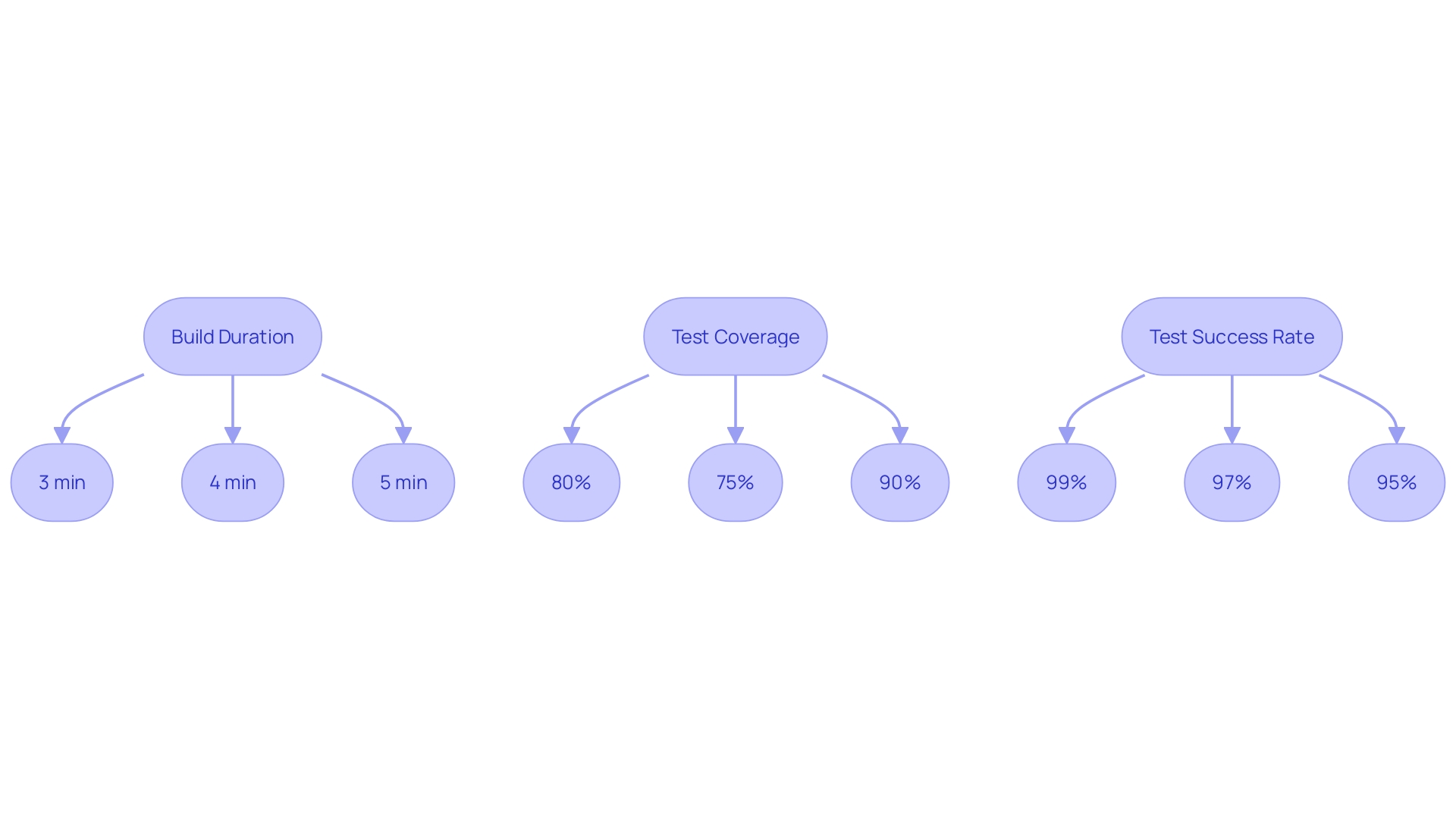
Feedback and Iteration
To optimize the Continuous Integration (CI) process, it is crucial to incorporate feedback from both developers and stakeholders. This practice allows teams to pinpoint inefficiencies and swiftly resolve any emerging issues, thereby enhancing the overall CI workflow. M&T Bank's initiative to establish Clean Code standards exemplifies a proactive approach to maintaining code quality and compliance, which is essential in the banking sector where security and regulatory adherence are paramount.
Automated testing, including unit testing and Test Driven Development (TDD), plays a vital role in CI by enabling early detection of defects and ensuring that the introduced changes perform as expected. These automated tests serve as a quality gate, reducing the chances of introducing errors that could lead to security breaches or compliance issues. As highlighted by recent insights from the Developer Experience Lab, improving the development experience through tools like AI pair-programming assistants can significantly boost productivity while mitigating risks associated with developer burnout and retention.
Moreover, empirical analysis of data from thousands of developers can inform best practices regarding the optimal size of pull requests. This data-driven approach ensures that code reviews are manageable and constructive, contributing to a more efficient CI process. By continually refining these practices and leveraging the latest in development research, organizations can achieve a more agile, quality-focused, and sustainable software development lifecycle.
Learning from Failures and Continuous Improvement
Continuous Integration (CI) is not simply a feature of software development; it is a catalyst for learning and improvement. The experience of AT&T, which has a rich history dating back to 1885, exemplifies the challenges of unwieldy systems and policies that can stifle innovation. They were inspired to revitalize their approach due to employee feedback highlighting frustrations with existing tools and processes.
Similarly, TBC Bank, in its quest to enhance the banking experience, undertook an agile transformation to reduce complexity and accelerate digital product time-to-market. This initiative aimed to foster growth by embracing modern working principles while tackling technical debt and inter-team dependencies.
Pinterest's journey, which began in 2010 with a single engineer, teaches us the importance of using proven technologies and the value of innovation balanced with simplicity. By March 2012, Pinterest had already reached 11 million monthly active users with a team of just six engineers.
These case studies underline the essence of CI: a practice where software can be released to production at any time, emphasizing the regular and automated merging of code changes from multiple contributors. This process aims to detect integration issues early, thereby enhancing collaboration and efficiency.
Supporting this, statistics reveal that AI pair-programming tools significantly boost developer productivity across all skill levels, with junior developers reaping the largest benefits. Such tools offer AI-generated code suggestions, reducing cognitive load and enhancing the overall development process.
As quoted by industry experts, embracing one's strengths within the myriad components of a project—from architecture to marketing—can lead to successful outcomes. Furthermore, it's crucial to acknowledge that most high-impact ideas are not immediately apparent and that the failure rate of new tech products is considerable.
By focusing on vision, strategy, and target outcomes, organizations can prioritize effectively and navigate the phases of discovering, designing, testing, and ultimately delivering products that resonate with customers and advance the product's value.
Post-Mortem Analysis
Post-mortem analyses are a critical component of continuous improvement in software development. Following a failure in a build or test, it's essential to dissect the event thoroughly to pinpoint root causes. Perspectives on the reasons for failure may vary significantly depending on whom you consult.
Engineers may point to a lack of formal verification or insufficient error tracing. Project managers might highlight poor management of outsourced tasks or inadequate knowledge transfer. Such varied insights underscore the complexity of diagnosing software issues and reinforce the need for a comprehensive review process.
By studying and understanding the behavior of systems, as highlighted in industry performance evaluations, developers can anticipate the limitations and problems that may arise. This kind of reflection exposes non-obvious system properties and drives improvements, not just in the current system, but also in the intuition of developers, leading to the creation of more robust systems in the future. For instance, the outage experienced by Graphite, as shared by CTO Greg Foster, illustrates the importance of transparency and the need to learn from failures to strengthen community trust and prevent future incidents.
Moreover, strategic technical debt is a concept that research-oriented companies must grapple with during the exploration and exploitation phases of project development. The goal is to explore diverse solutions quickly, and then robustify the most promising one into a viable product. Optimal practices differ significantly between these phases, suggesting that the approach to post-mortem analysis may also need to be tailored accordingly.
Statistics from AI pair-programming tools, such as GitHub Copilot, indicate that productivity enhancements from AI suggestions cover all aspects of development, including product quality. This suggests that incorporating AI tools into the post-mortem process could further aid in identifying failure points and improving code quality.
In conclusion, a thorough post-mortem analysis is not only about resolving immediate issues but also about enhancing team capabilities and product quality over time. By incorporating diverse perspectives, performance evaluations, strategic considerations, and AI-assisted insights, organizations can turn build or test failures into opportunities for significant advancement.
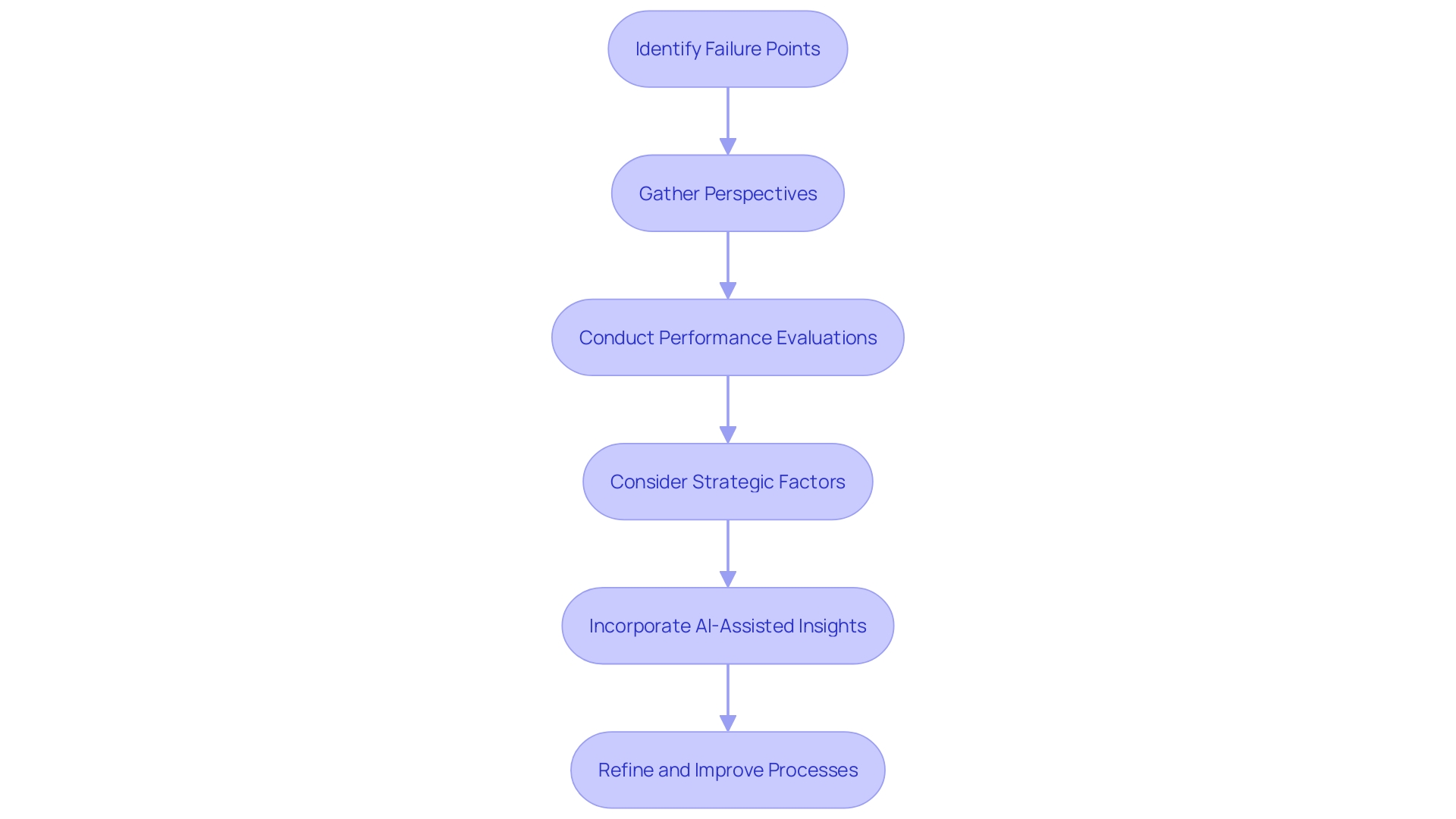
Iterative Refinement
Refining your Continuous Integration (CI) system is an ongoing journey that hinges on feedback and the collective efforts of your team. Successful CI is like a well-oiled machine, where the gears of experimentation and incremental delivery work in tandem to drive efficiency. By embracing the first principles approach, you can uncover gaps in your CI pipeline and innovate solutions tailored to your specific challenges.
For instance, consider the case of Earthly CI, which avoided an overly complex implementation by focusing on early-stage validation. This approach garnered a small yet passionate user base, whose enthusiasm was a clear signal of the product's resonance. Similarly, improving CI build times involves not just identifying opportunities but also validating your understanding through experimentation without excessive time investment.
This iterative process ensures each increment propels you closer to your CI goals.
It's essential to recognize that CI is a team sport—'it takes a village' to foster a culture of continuous improvement. By working towards shared objectives, each contribution becomes a building block for a robust CI system. A case in point is Thoughtworks, a company renowned for its culture and technological excellence.
The global presence and ability to retain top talent underscore the impact of a cohesive, innovative culture on technology practices.
Moreover, the parallels between software engineering and manufacturing offer valuable insights. Just as factories undergo meticulous planning and updates to enhance production, software engineering requires similar diligence. The shutdowns for line maintenance and updates in manufacturing are akin to the cycles of reflection and improvement in CI systems.
This meticulous process ensures that the technology not only meets current needs but is also primed for future innovations.
Incorporating these principles into your CI practice not only refines your system but also aligns it with the broader technological landscape that is increasingly influenced by AI. Observations from GitHub on the growth of AI in software development remind us that CI systems must adapt to the changing nature of code creation and integration. As AI continues to shape the development process, monitoring its impact on code quality and developer behavior is crucial for maintaining a competitive edge.
Through collective effort, strategic experimentation, and a commitment to continuous improvement, your CI practices will not just keep pace with technological advances but lead the charge in driving efficiency and innovation in software development.
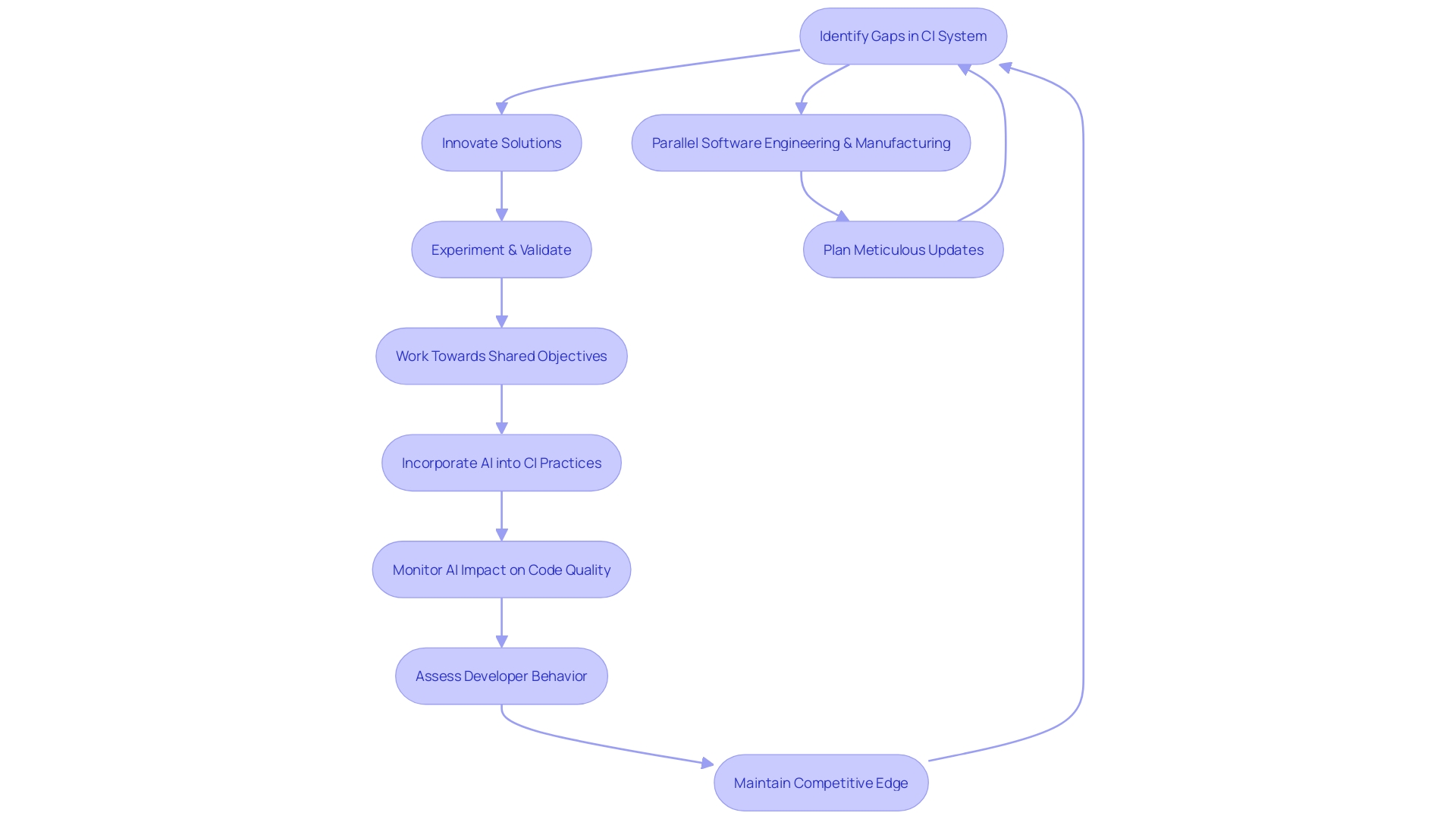
Conclusion
Continuous Integration (CI) has redefined the process of software development, establishing itself as a philosophy that champions early detection of issues, collaborative coding, and a relentless pursuit of quality. The practice is underpinned by automated processes and version control systems that ensure a seamless and efficient workflow, making integration issues a rarity and fostering a culture of shared responsibility.
Industry case studies, including the evolution of Workable's Applicant Tracking System, demonstrate the scalability and quality benefits of CI, highlighting its necessity for maintaining standards, especially in tightly regulated sectors like banking. As the software landscape evolves with new technologies like AI and cloud services, CI tools such as Jenkins, Travis CI, and CircleCI continue to advance, offering solutions that align with the ever-changing demands of software development.
CI's contribution to software delivery is invaluable, offering increased speed, improved quality, and cost efficiency. It is an essential component of the development lifecycle, from initial coding to final deployment, promoting agility and a focus on quality that resonates with both developers and users. As organizations strive for excellence in a competitive digital economy, CI stands as a key driver of innovation and success in software engineering.




